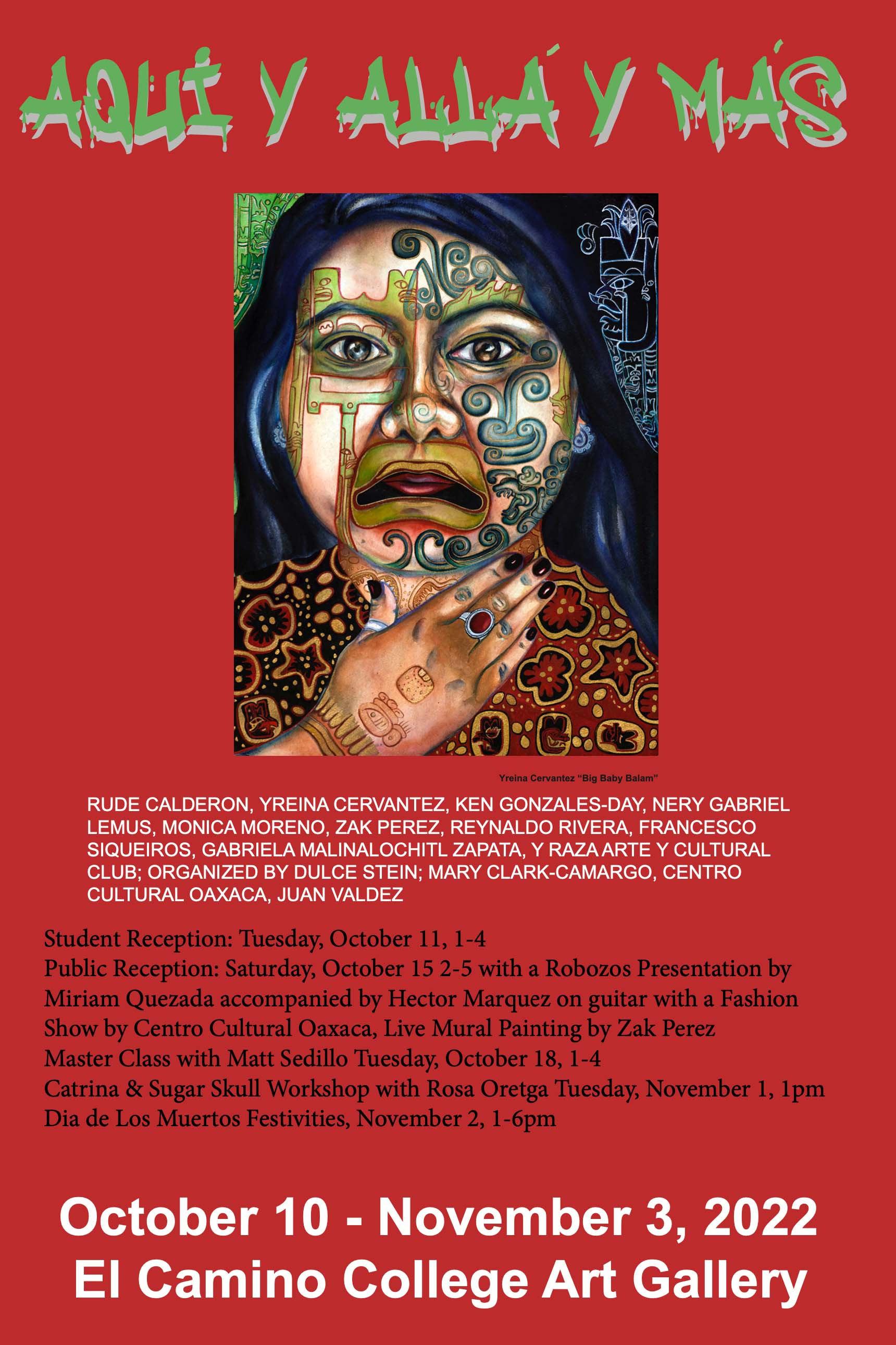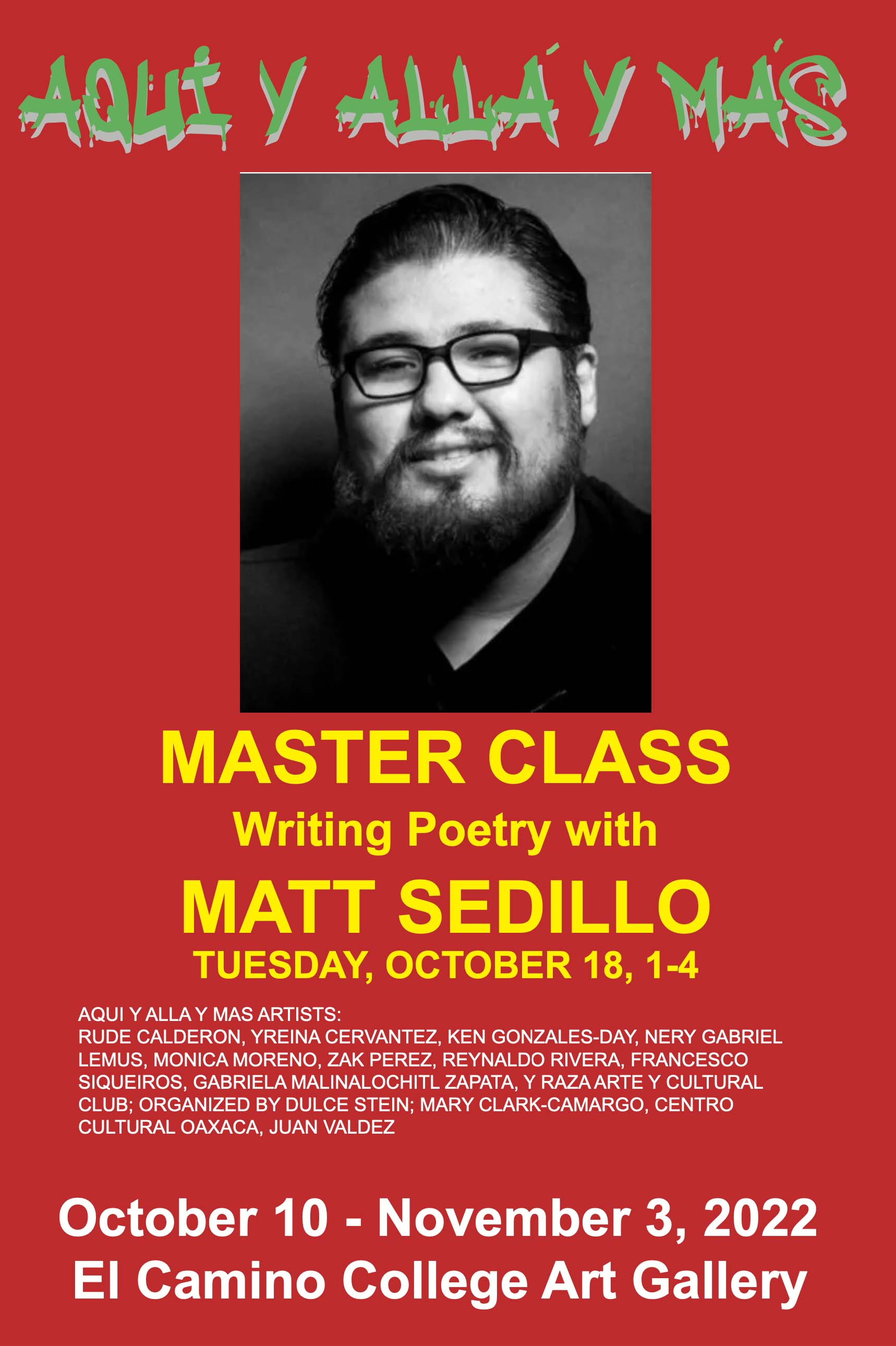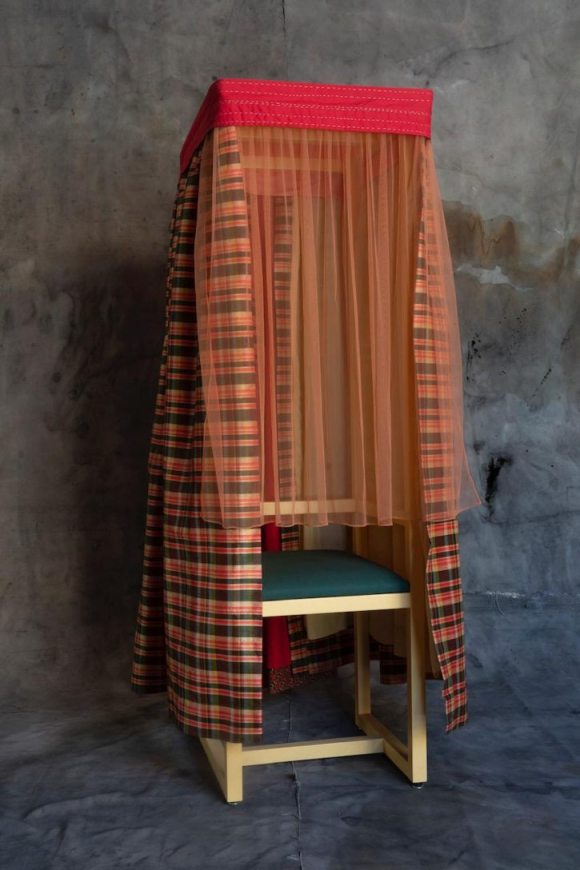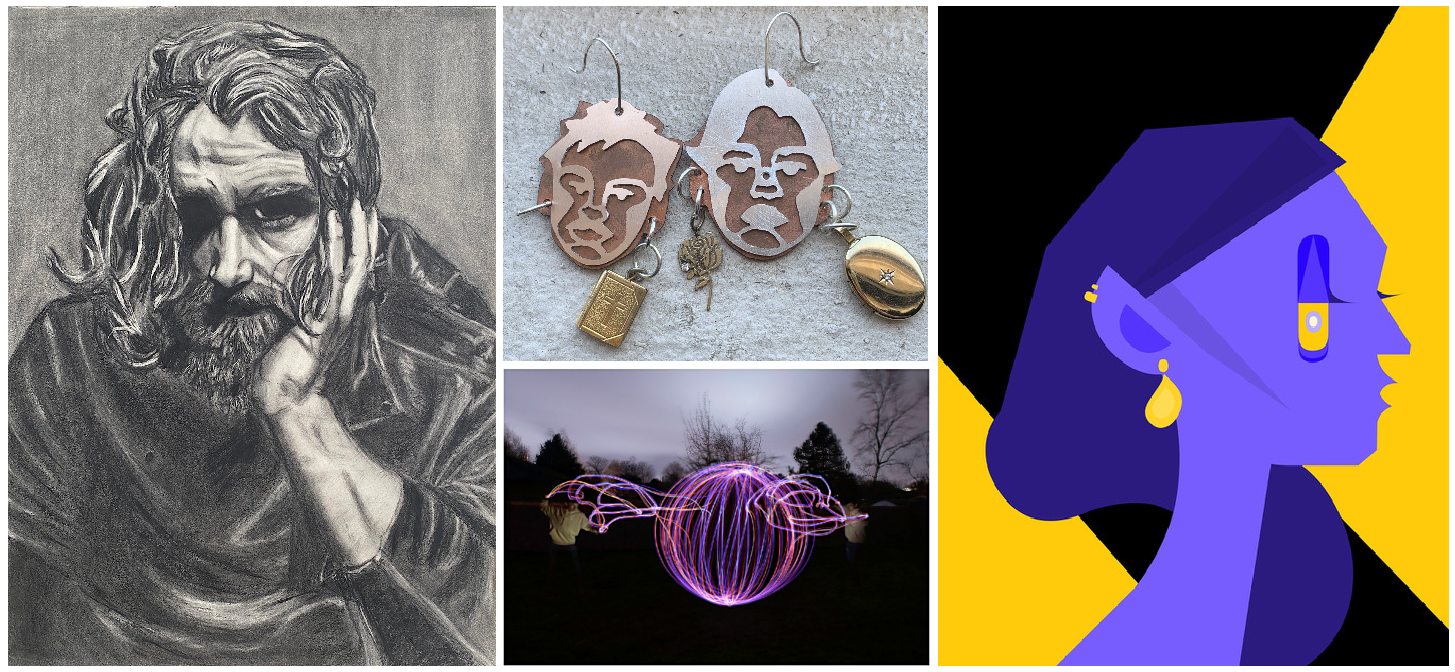
Recent Exhibitions
Peruse recent and past exhibitions from El Camino's Art Gallery collection.
View Past Collections
Life and Love in the Big City: how we doin' out there?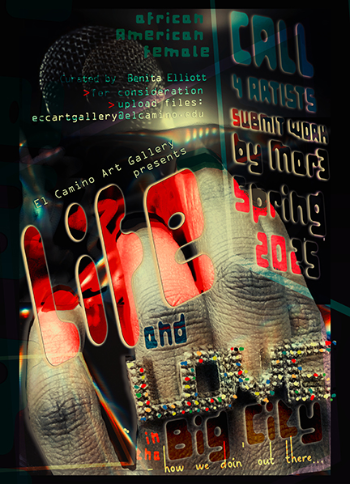
Closing Reception: Wednesday, May 14 from 1:00pm-3:00pm
El Camino College Art Gallery announces our first Spring 2025 exhibition in celebration of the creative aesthetic visions of black female artists.
Life and Love in the Big City - how we doin' out there... has at the heart celebration and support of the creative spirit.
We are here to activate connections with each other and with El Camino mentors championing successes as practitioners.
El Camino Art Gallery envisions an incubator for black women, students and mentors for on-going mentorship, development and support.
Featuring artists: Zionna Hoyt, Sandra Derrell, Ruth Pinchaent, Karen Medley
Xicana! 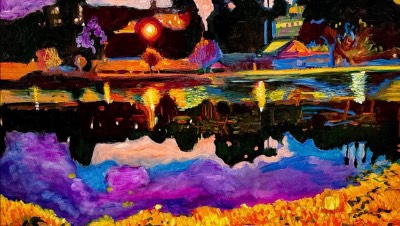
Curated by Dulce Stein
September 16 – December 14, 2024. Monday – Friday, 3pm – 5pm.
Opening reception held Thursday, September 26, 2024 from 4pm – 9pm. Curatorial walkthrough and artist conversations at 6pm. Poetry reading by Masiela Montserrat Corona.
El Camino College Art Gallery and ESMoA present the Xicana! Exhibition in the former Art Gallery in the Arts and Behavioral Science building. Rooted in the sociopolitical movements of the 1960s and 1970s, Chicana art has become a dynamic force within both American and Latin-American cultures. It serves as a profound medium for artistic expression, social commentary, and the formation of cultural identity. Featuring over 70 prominent Chicana artists, it acts as an educational platform, emphasizing the cultural and social importance of Chicana art while contributing to a more inclusive cultural dialogue.
XICANA! EVENTS
Halloween and Day of the Dead Festival Prep
Thursday, October 31, 2024 1pm - 3pm
Flowers Workshop @ ESMoA
Satuday, October 12, 2024 1pm - 3pm
Diosa Book Release
Saturday, October 12, 2024 4pm - 7pm
Open Mic
Wednesday, October 16, 2024 1:15pm - 3:15pm
Flowers with Griselda
Tuesday, October 22, 2024 1:15pm - 3:15pm
XICANA! Artist Talk: XIGONA
Saturday, November 16, 2024 4pm - 6pm
Open Mic
Wednesday, November 20, 2024 1:15pm - 3:15pm
Doodle and Dream
co-curated by Lauren Kasmer and Michael L. Miller
August 26 - October 3, 2024
Opening Reception:
Thursday, September 5, 2024, 6-8:30pm
PAMELA BURGESS, SERGE ATTUKWEI CLOTTEY, SHANA NYS DAMBROT & OSCEOLA REFETOFF, RIC HEITZMAN, BONITA HELMER, LINDA JACOBSON, BRUCE KASMER, LAUREN KASMER, WILIAM LEMON, RODNIE NELSON, JOANNA SKUMANICH, ESTHER PEARL WATSON, JODY ZELLEN
DOODLE AND DREAM EVENTS
Artist Conversations and Curators Walkthrough
Tuesday, September 17, 2024, 1:15 - 3:30
Paper-Maiche Workshop with Joanna Skumanich
Saturday, September 21, 2024, 1:00-4:00
Dream Workshop with Linda Jacobson
Thursday, September 26, 2024, 1:15 - 3:30
Zoom Meet a 3-D artist with Lynda Weinman
Tuesday, October 1, 2024, 1:15 - 3:30
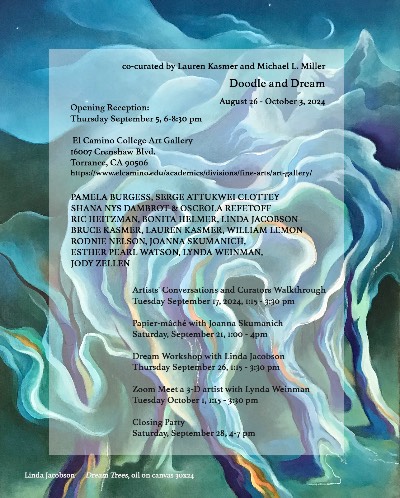
Annual Summer Open Call 2024
TH, F, SAT: 11:00 AM - 4:00 PM
2024 Winners: Darlyn Susan Yee (1st), Steve Abshear (2nd), Carol Erilane (3rd), Erica A. Marshall (3rd)
2024 Honorable Mentions: Chris Lee, Ikus, Karim Shuquem, Joey Moreno, Leslie S Chavez, Francisca Vergara, Jung Ferrell, Griselda Renteria, Feylicity Kanz, Louise Ivers, Atsuko Sepmeyer.
Open Call is a fundraising event to support programming in the Art Gallery
Soft Opening: July 11, 2024
Opening Reception and Award Ceremony: July 13, 2024
Closing Reception: August 3, 2024
Gallery Hours:
Thursday, Friday, Saturday 11am - 4 pm
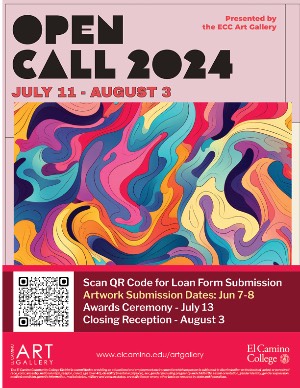
Fine Arts Student Exhibition
Featuring Artwork from the Fine Arts Department Students
May 13 - June 5, 2024
Artwork Pickup: June 6, 2024, 9 am - 3 pm
ECC Student Work - Digital Arts
Open House Reception
Featuring Artwork from the Fine Arts Department Students
May 17, 2024, 4pm - 7pm
Special Exhibition: Mariko Motoyama - An Oral History of Internment Presentation (collaboration with Library Film Archives)
Featuring Mariko Motoyama
Celebrating Asian American Month
Thursday, May 16, 2024, 1 pm - 4 pm
About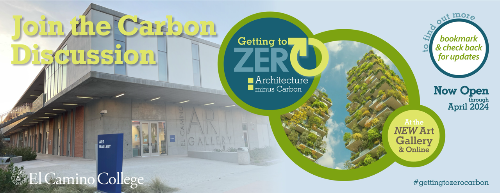
Getting to ZERO is an exhibition and event series that centers around the topic of decarbonization within the design and building industries. Considering that the construction and operations of buildings account for nearly 40% of the total carbon emissions and 23% of the construction debris that is sent to our waste streams, El Camino’s architecture students designed sustainable strategies that aim to generate minimal or zero carbon and waste.
Anchored by an exhibition of student case studies, construction models, and design proposals that demonstrate sustainable practices in architecture and building technology, the series will explore what it means to achieve zero. This will include industry presentations, student exchanges, and discussion forums all designed to engage visitors on ways to be stewards of our environment.
Highlights
02.22 student exhibit opens
02.28 student to student exchange
02.29 getting to zero official kick-off
03.13 the arts complex building case study
03.19 water: LA's elusive resource
03.26 women leading the charge in sustainability
04.18 getting to zero roundtable
04.20 architecture, community, and earth
04.25 exhibition closes...but the effort continues
Indigenous Music & Art Tour
The Indigenous Music & Art Tour Exhibition will be open from Thursday, September 21 through Thursday, December 21, 2023
On loan from Dr. William Doyle and Wendy Stockstill, the El Camino College Art Gallery presents a diverse
collection of musical instruments from different regions including Peru, North America,
Aztec/Mayan, Papua New Guinea, and Australia. The sounds associated with each of
these places has an added dimension of visual language through the design and artistry
of the instruments that emit them.
Indigenous Music & Art Performance:
Saturday, September 30, 2023 7 p.m. - 9 p.m.
In conjuction with
300 ACTIONS: Community Art Exhibition
An interactive El Camino College community art exhibition.
Please vist our "Workshops & Events" for more information
Public Reception: Saturday, September 23rd 2 p.m. - 5 p.m.
Campus Reception: Thursday, September 21st 1 p.m. - 4 p.m.
Gallery Hours:
Monday, Tuesuday, Friday 10 a.m. - 6 p.m.
Wednesday, Thursday 9 p.m. - 3 p.m.
El Camino College Student Exhibition
2023 May 15 - June 1, 2023
Campus Reception:
Tuesday, May 16, 1-4
Public Reception: Saturday, May 20, 2-5
Open Mic Night: Saturday, May 20, 6-9
Daily Workshops Artist Conversations
16007 Crenshaw Blvd
Torrance, CA 90506
Weekday Parking: Lot L
Weekend Parking: Lot J, Lot K, Lot L
Hours: M-Tu 10-6pm, W-Th 10-4pm

California Native Plants
THERE’S NO PLACE LIKE HOME:
California Native Plants
Alicia Beach, Randall Von Bloomberg, Pamela Burgess, Gus Harper, Nancy Haselbacher, Connie Jenkins, Ed Lum, Vilma Mendillo & Laura Stickney, Jane E. Pinheiro, Pat Warner and the Theodore Payne Foundation Seed Museum with Genny Arnold.
The El Camino College Art Gallery proudly presents an Exhibition in honor of California native landscapes and plants as well as offering beach clean up and conservation efforts in honor of Earth Day celebrations.
Continuing on Campus: Shout it to the Wind, sculpture and performance space by Joyce Dallal.
March 27 – April 27, 2023
Student Reception
Tuesday, April. 4, 1-4 p.m.
Public Reception
Saturday, April 15 & Sunday, April 16 2-5 p.m.
Coinciding with the Theodore Payne Foundation Garden Tour
Important Dates
Thursday, March 30, 1-4 p.m.
BACK BY POPULAR DEMAND: Laura Stickney & Vilma Mendillo Printmaking and Bookmaking
Workshop
Tuesday, April 4, 1-4 p.m.
Campus Reception and Workshops : Aromatherapy, Seed Bombs, and Guerilla Gardening
Saturday, April 15 & Sunday April 16, 2-5 p.m.
Public Reception and Theodore Payne Foundation Garden Tour (10-5)
April 17 through April 20
Making Art out of Trash collected from So. Cal. Beaches for Earth Day
Tuesday, April 18, 1-4 p.m.
Artist Conversations
Saturday, April 22, 2-8 p.m.
Earth Day and Beat Not Beat Poetry Reading
Tuesday, April 25, 1-4 p.m.
Genny Arnold: Theodore Payne Foundation Seed Museum Conversation
Daily Workshops Screen printing, soft sculpture construction and more. Check our posted Calendar for further dates.
Due to Popular Demand, we are increasing Hours on Thursday!
Gallery Hours
Monday & Tuesday 10-6 p.m.
Wednesday 10-4 p.m.
Thursday 10-4 p.m.
Edith Abeyta:
BELOW OUR FEET AND ABOVE OUR HEADS: FENCELINE RESISTANCE FROM PENNSYLVANIA TO CALIFORNIA
November 21 – December 15, 2022
You are invited to participate in the construction of elements of the exhibition November 14 – November 19, 2022.
- Master Class with Edith Abeyta, Tuesday, November 29, 1-4pm
- Campus Reception, Wednesday, November 30, 1–4pm
- Public Reception, Saturday, December 3, 2-5pm
- Social Justice Workshop, Tuesday, December 6, 1-4pm
- Addition online programming throughout the exhibition

An exhibition organized by artist and fenceline community member Edith Abeyta in collaboration with artists, activists, organizers, colleagues, academics, students, and friends In towns and cities across the world fenceline communities are protecting their land, water, and air by going up against powerful corporate interests with their bodies, minds, and hearts. Artist and fenceline community member, Edith Abeyta from Braddock, Pennsylvania will transform the El Camino College Art Gallery into an environmental justice hub, constructing a space for networking, conversations, and resources with interactive sculptures, photography, film, workshops, and events. Embracing the community in community college Abeyta will work with various departments to amplify the campus as a resource not only for students, faculty, and staff but also for residents, activists, and artists in the region.
This exhibition, part static artworks, part interactive workshops highlight some of the processes of people from many sectors who are working towards a more just future and dismantling sacrifice zones. Using data from crowd sourced purple air monitors across the country, victory headlines of environmental justice communities, visualizations of heartbeats, university implemented surveillance cameras, and DIY air filters, Abeyta and the many collaborators who made this exhibition possible visualize some of the aspects of environmental justice work.
Aquí y Allá y Más
Miriam Quezada presents an interactive History of Rebozos fashion show and video, with Hector Marquez on guitar. Live painting with Zak Perez. Master Class in Writing Poetry with Matt Sedillo Tuesday, October 18, 1- 4 p.m.
Artist Talk on Tuesday, October 25, 1 p.m.
The art in this exhibition is a presentation of a few of the many voices from the Mexican, Mexican-American, Latino, Chicano and Latinx cultures. Rude Calderon, Yreina Cervantez, Ken Gonzales-Day, Nery Gabriel Lemus, Monica Moreno, Zak Perez, Reynaldo Rivera, Francesco Siqueiros, and Gabriela Malinalxochitl Zapata. The Raza Arte y Cultural Club of El Camino College, organized by Dulce Stein and including Mary Clark-Camargo, Juan Varela, Rosa Ortega, Maria Palacios, CENTRO CULTURAL OAXACA traditional repujado technique, Professor: Griselda Renteria and Students: Candida Hernandez, Rosita Gonzales, Maria Platas, Marylu Hinojosa, Alma Morales, Gustavo Millan and Maria Ochoa, will also present works.
The Art Gallery will present a Master Class poetry workshop by Master Poet, Matt Sedillo on October 18, 2022 starting at 1:00 p.m. Artists will speak about their work on October 25, 2022 starting at 1:00 p.m.
Rosa Ortega will host a Sugar Skull workshop on November 1 at 1 p.m. The Gallery and the Raza Arte y Cultural Club will host Dia de Los Muertos festivities on November 2, 1-6 p.m.
EL CAMINO COLLEGE ART GALLERY
16007 Crenshaw Blvd. Torrance, CA 90506
310-660-3010
Gallery Hours: Monday & Tuesday 10 a.m. - 6 p.m., Wednesday 10 a.m. - 4 p.m., Thursday 12 - 4 p.m.
Exhibition Dates: October 10 - November 3, 2022
Campus Reception: October 11, 1-4 p.m.
Public Reception: October 15, 2-5 p.m.
SOUNDS
El Camino College Art Gallery is proud to present the SOUNDS Exhibition featuring works by Fatemeh Burnes, Robert Hilton, Tom Jenkins, Elana Mann, Mei Xian Qui, Peter Rice, and Susan Silton. SOUNDS explores the connections between humans and sound through audible and visual means. The human desire to make sounds, whistle like birds and communicate with other humans is essential. How do we imagine sound? What emotions do sounds evoke? What does sound look like?
EL CAMINO COLLEGE ART GALLERY
16007 Crenshaw Blvd. Torrance, CA 90506
310-660-3010
Gallery Hours: Monday & Tuesday 10a.m. - 6p.m., Wednesday 10a.m. - 4p.m., Thursday 12 - 4p.m.
Exhibition Dates: August 29 - September 22, 2022
Reception: Wednesday, September 7, 1-4 p.m. at the art gallery
Public Reception: Saturday, September 10, 2-5p.m. with performances by the South Bay Strummers, artist
Robert Hilton, and artist Peter Rice
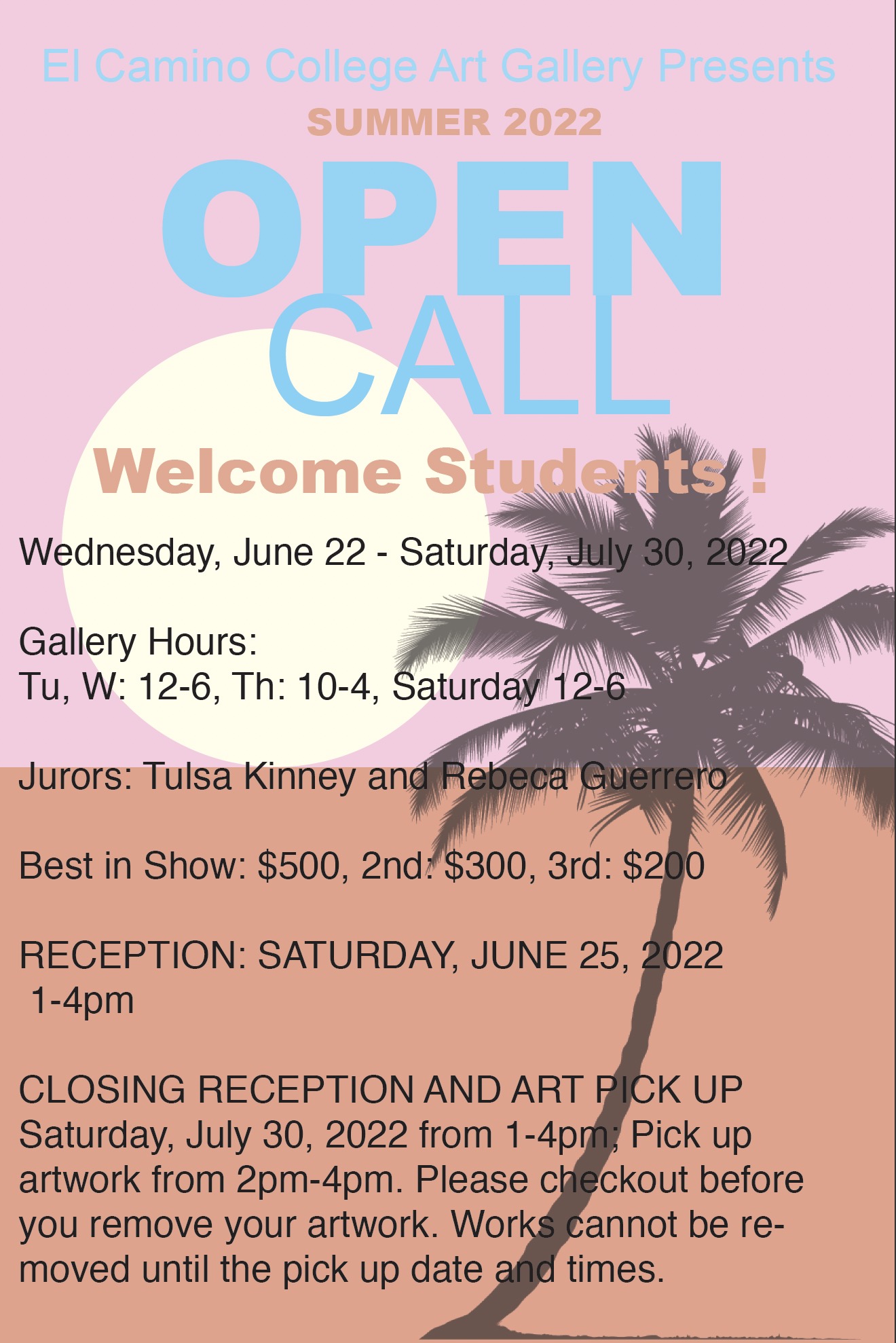 El Camino College Art Gallery Presents - Summer 2022 Open Call.
El Camino College Art Gallery Presents - Summer 2022 Open Call.Summer 2022 Open Call
EL CAMINO COLLEGE ART GALLERY
16007 Crenshaw Blvd. Torrance, CA 90506
310-660-3010
Gallery Hours: Tues & Wed 12-6 p.m., Thurs 10-4 p.m., Sat 12-6 p.m., Fri, Sun, Mon: Closed
Exhibition Dates: June 22-July 30, 2022
Reception: Saturday, June 25, 1-4 p.m. at the art gallery
Jurors: Tulsa Kinney and Rebeca Guerrero
Best in Show: $500, 2nd: $300, 3rd: $200
CLOSING RECEPTION AND ART PICK UP
Saturday, July 30, 2022 from 1-4pm; Pick up artwork from 2pm-4pm. Please checkout before you remove your artwork. Works cannot be removed until the pick up date and times.
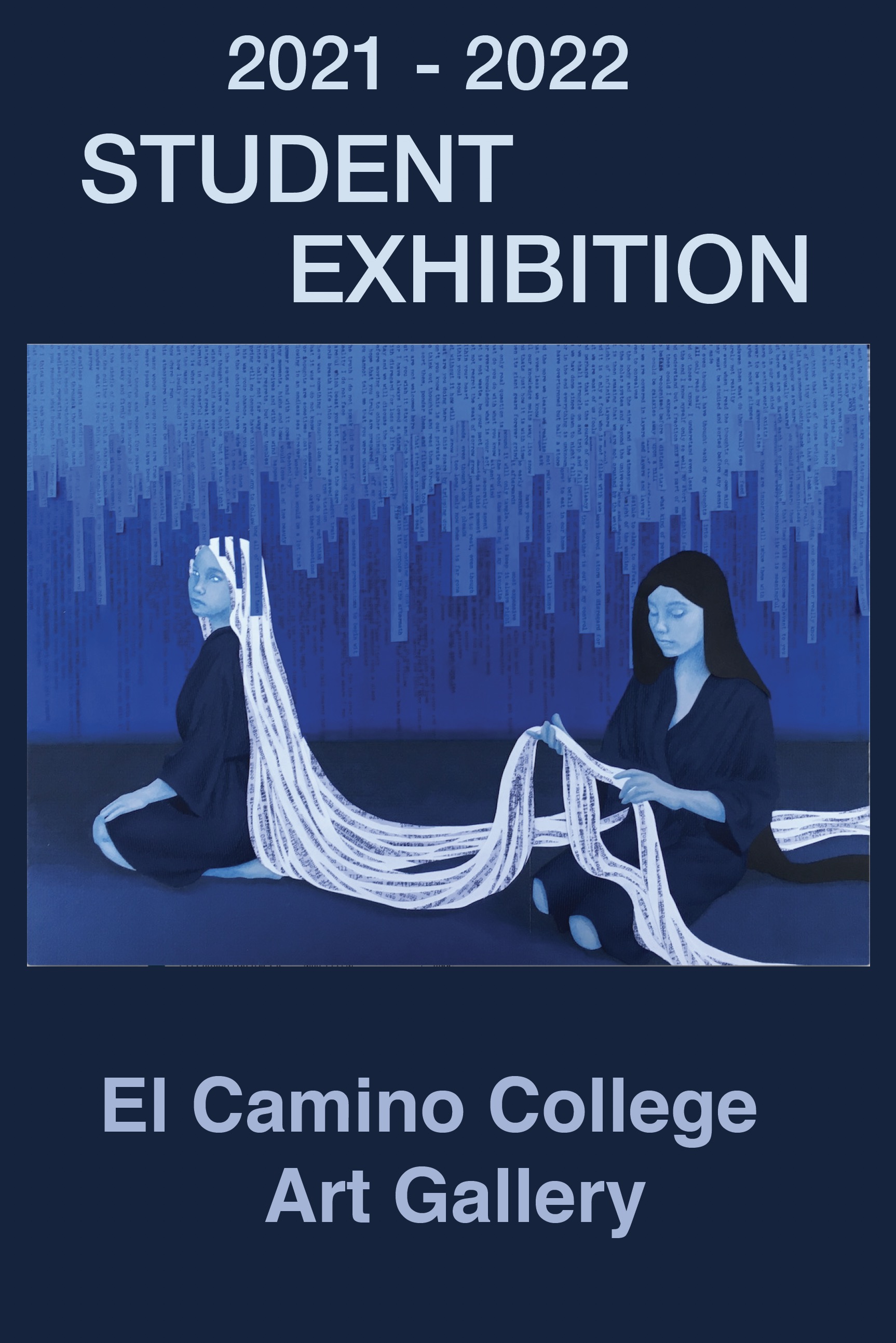 Shruti Walker: Dawning Thoughts : 20 X 15 : Mixed Media, marker, colored pencils,
typed paper
Shruti Walker: Dawning Thoughts : 20 X 15 : Mixed Media, marker, colored pencils,
typed paper2021-2022 Student Exhibition
STUDENT EXHIBITION 2022
RETURN TO CAMPUS POST PANDEMIC, SPRING 2022
El Camino College Art Gallery is pleased to present works from the students of the El Camino College Art Department, Spring 2022. This is the first semester back on campus for many returning and new students. All of the artwork in this exhibition has been selected by the instructors of each of the studio classes, awarding outstanding students in each section, placement in this exhibition. Despite an occasional departure from tradition, the majority of the works in this exhibit are grounded in an academic approach to art study and training.
The annual Student Art Exhibition includes a variety of art works from a wide range of two-dimensional painting media (oil on canvas, acrylic on canvas, watercolor on paper) as well as drawing media on paper (graphite, charcoal, ink, pastel and conte). Printmaking techniques include linoleum block, collography, etching and screen printing. The computer design classes produced video animation as well as photo-based laser printed graphic designs and illustrative pieces. Additionally, the exhibition includes a cross section of traditional three-dimensional techniques taught in the department – jewelry making; wheel thrown and slab-constructed clay vessels and hand-built objects as well as a variety of mixed media constructions. This Exhibition provides a unique glimpse into the educational and an aesthetic philosophy advocated by the El Camino College Art Department and illustrates a diversity characteristic of the contemporary art world.
The Student Exhibition may be characterized by an energy and vitality unique to emerging artists. Please join us in celebrating the creativity, talent and tenacity of this particular group of artists.
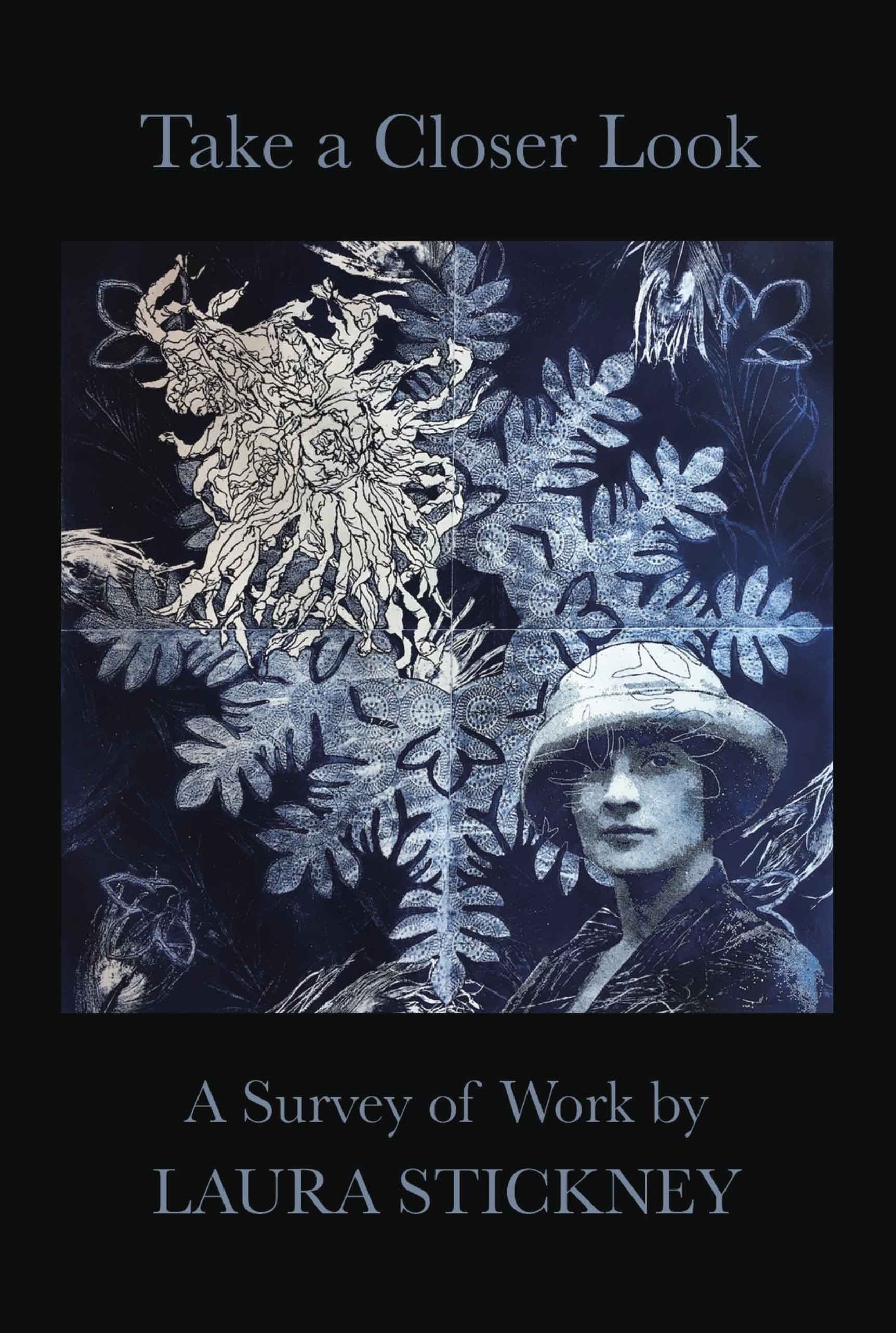 Take a Closer Look; A Survey of Work by LAURA STICKNEY
Take a Closer Look; A Survey of Work by LAURA STICKNEYTAKE A CLOSER LOOK
A Survey of Work by Laura Stickney
EL CAMINO COLLEGE ART GALLERY
16007 Crenshaw Blvd. Torrance, CA 90506
310-660-3010
Gallery Hours: Mon & Tues 9 a.m.-3 p.m., Wed & Thurs 1-7 p.m.
Exhibition Dates: February 14-April 29, 2022
Reception: Thursday February 24, 7-9 p.m.
Artist’s Talk: Tuesday, March 1 at 1 p.m. in the art gallery
" I think the heart of everything (I do) is looking at nature and finding stories
and connections."
Laura Stickney
Laura Stickney’s work evidences the keen nature of her gaze, a vision that finds beauty
in a leaf equal to photographic portraiture of women poets (Poet and Leaf Series)
and then spills into three dimensionality with artist’s books such as The Agave Book,
based on the strong form of an agave inflorescence, which was made while she was recovering
from cancer surgery; or the Madame Curie Cabinet of Curiosity that addresses the complexity
of the discovery of Radium. (Each of the book works and The Cabinet of Curiosity is
a result of collaboration with Vilma Mendillo, Stickney’s life partner).
Stickney circumspectly delves into women’s history, primarily in the US and Europe, employing techniques of etching and aquatint to include photographic portraits from the 19th and early 20th centuries along-side patterns derived from American quilting and lace, long considered women’s work. She deftly interweaves images and issues from present day life with techniques that could be seen as both antique and contemporary. In Stickney’s series of mythological goddesses the artist uses photographs of women from multi-racial backgrounds to depict her archetypal pantheon.
Using repurposed Polaroid film containers as her canvas Stickney uses oil paint to produce nearly psychedelic snap shots of flowers, sticks and pods bursting with juicy color and detail that urge the viewer to take a closer look at what’s around you. The most recent of the Polaroid paintings are individually dedicated to specific shooting victims in the U.S.
In a series of large black and white etchings, bee-keepers are featured as emblems of man in harmony with nature, where hooded humans tend bees and stand on a ground of enlarged leaves. Similarly orange vendors from the streets of Los Angeles populate another series of large black and white etchings dealing with man and nature.
Whether she is working with etching, aquatint, intaglio, silkscreen, monoprint, painting, drawing or book arts this artist and poet is simultaneously perceptive, but not didactic. She draws upon the riches of history to tell stories based sometimes in mythology, sometimes in actual fact, always expressing fundamental recognition of the importance of nature.
All visitors to the El Camino College campus will be required to show proof of Covid-19 vaccination. Masks are mandatory inside all buildings.
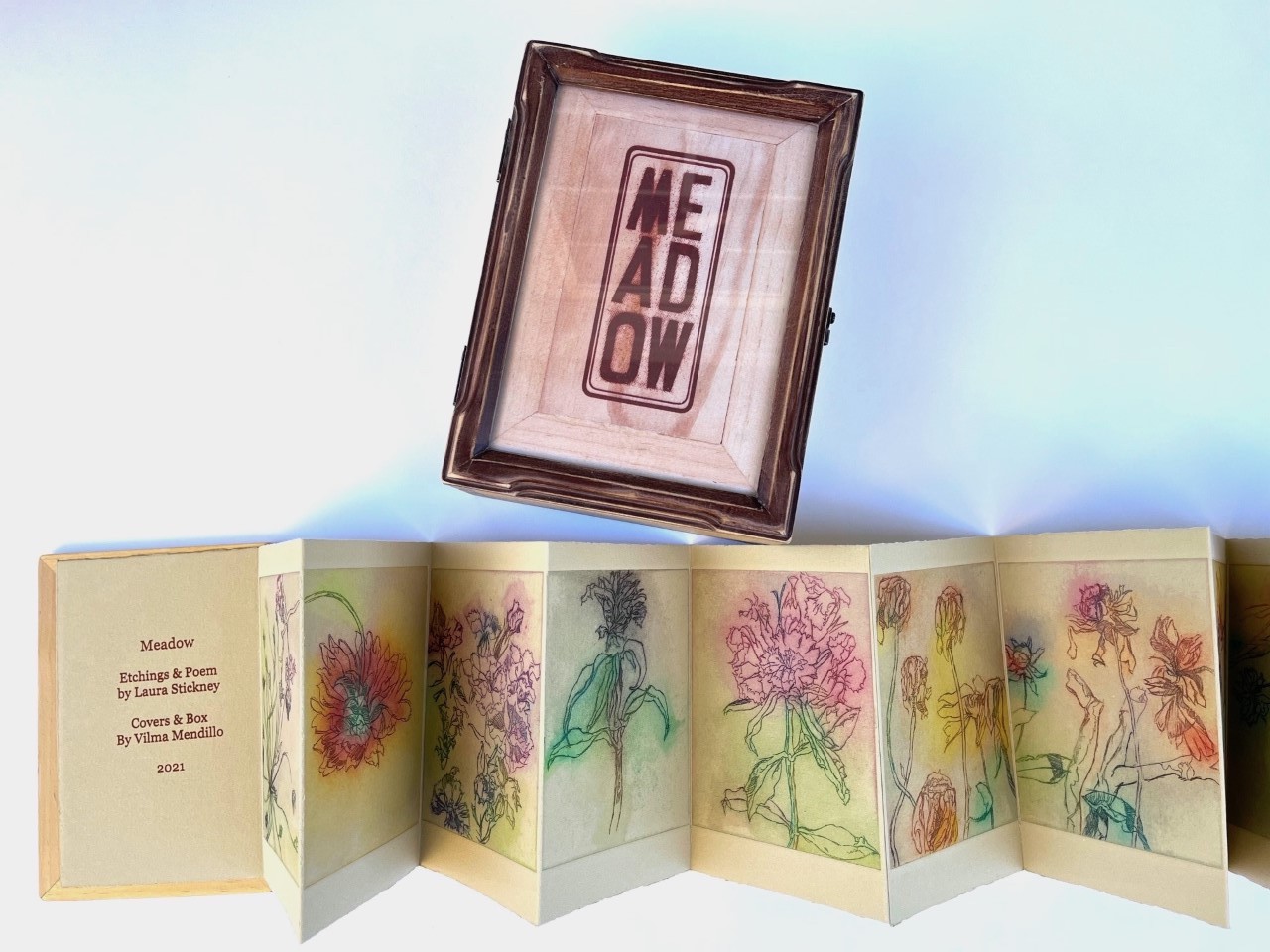
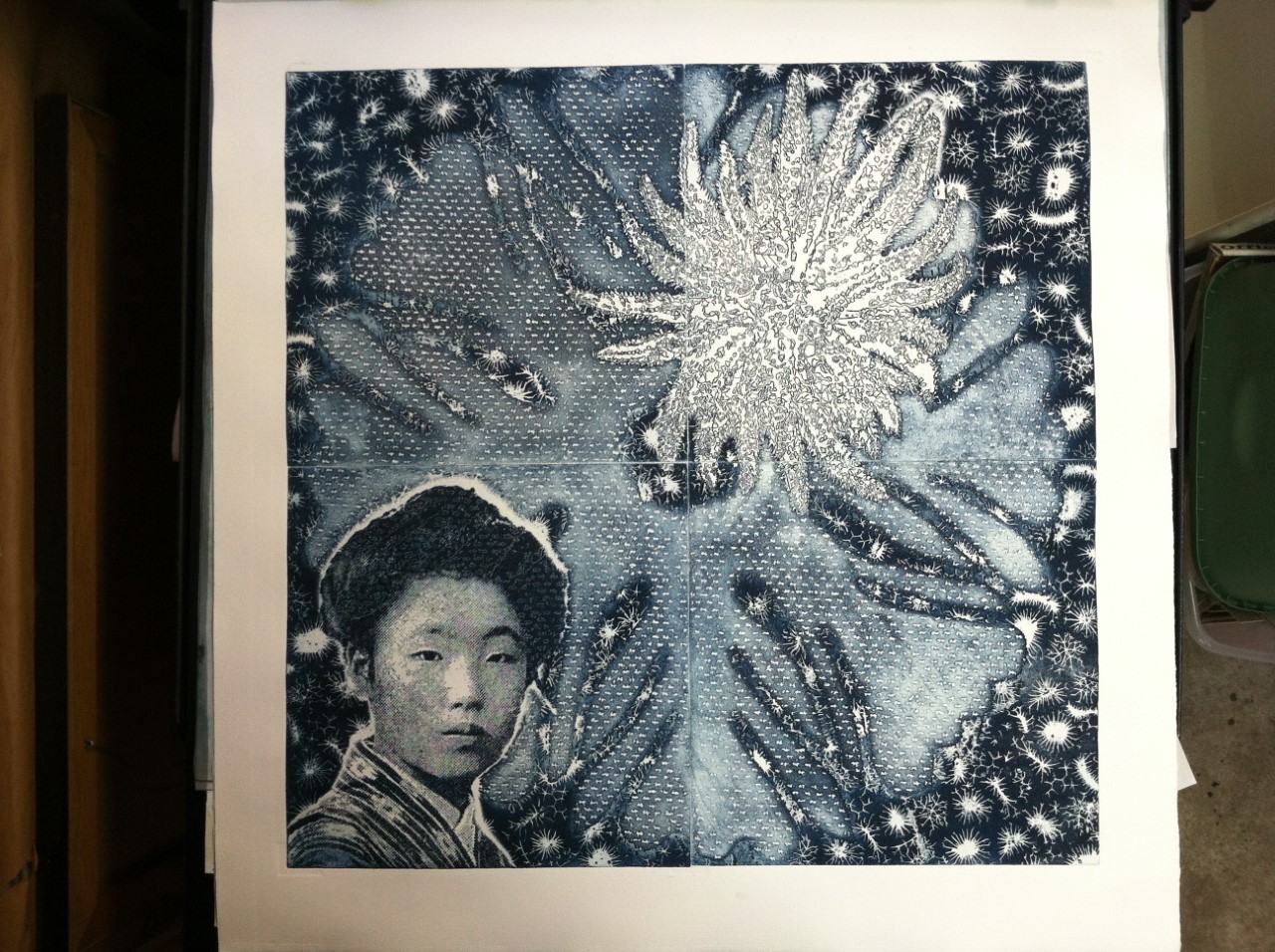
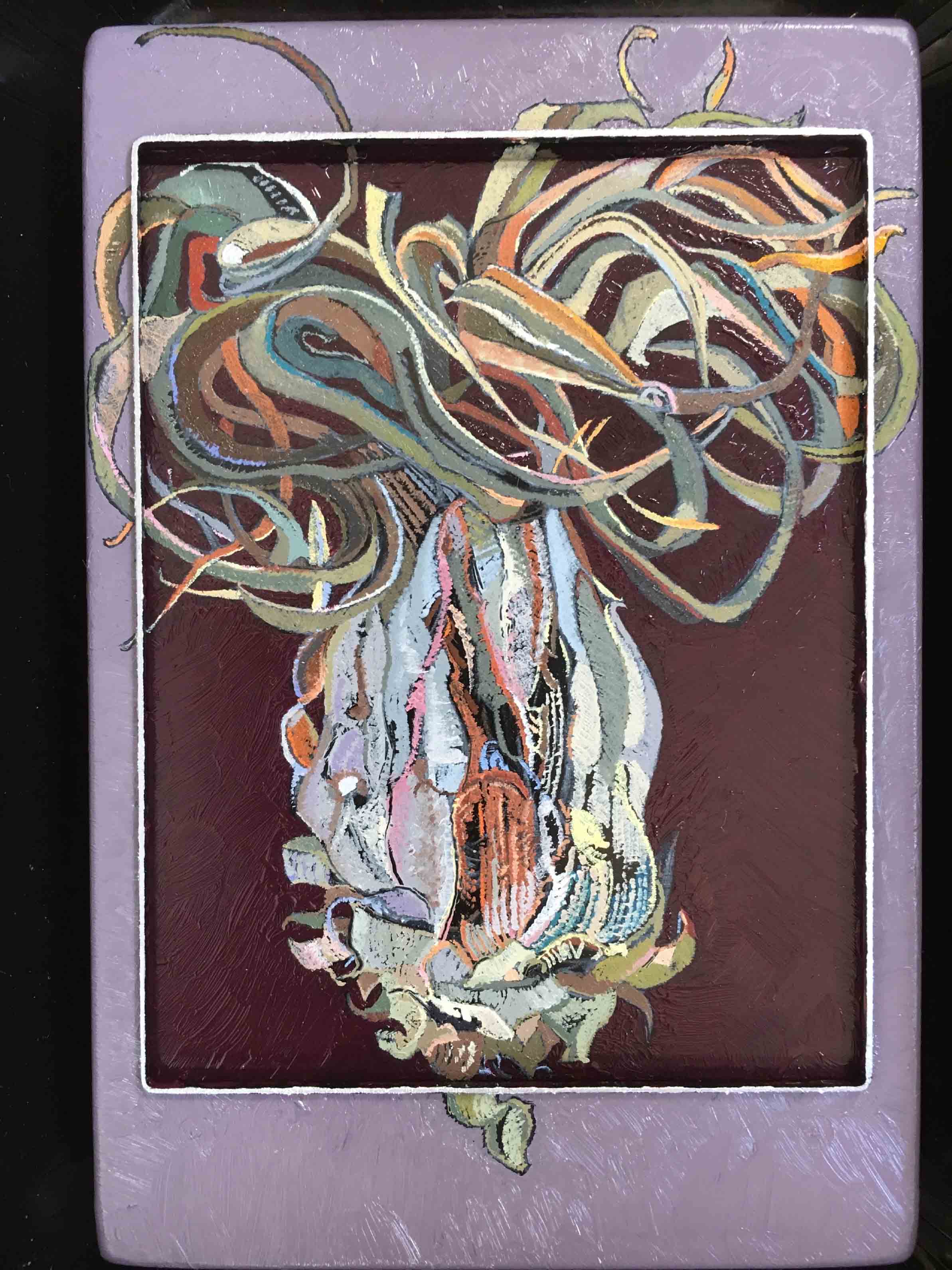

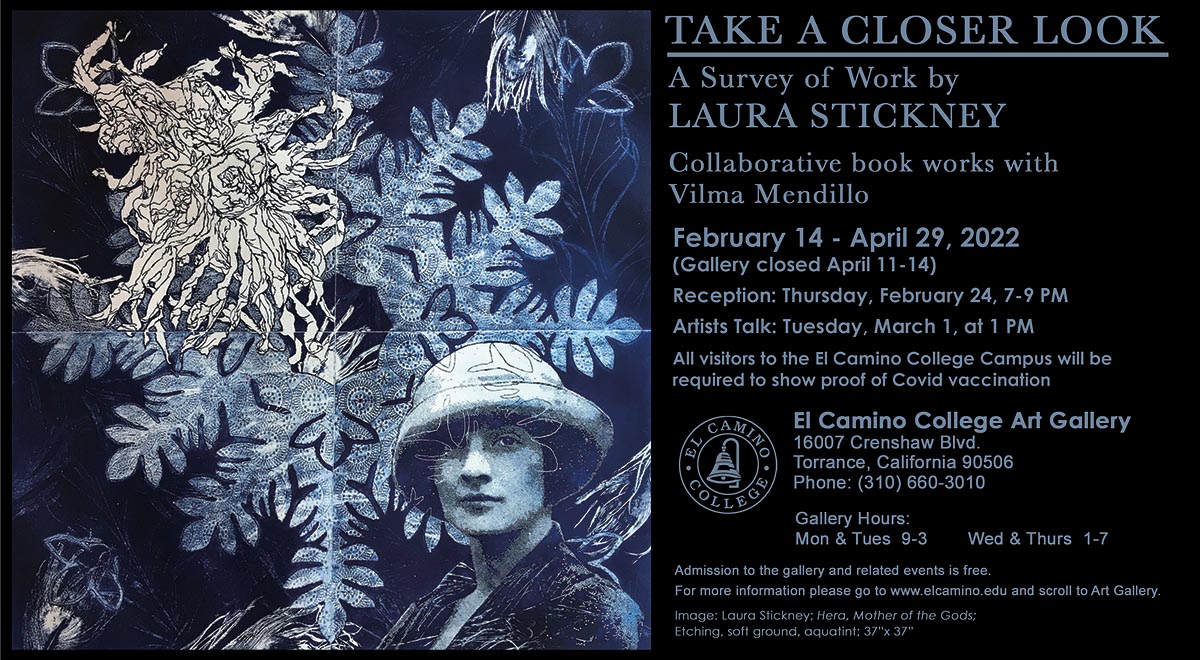
PHYLLIS GREENDRESS UPConstructing Other Selves October 29, 2021 – February 13, 2022
DRESS UP exhibit is available online only
These sculptures function as both objects of contemplation and props for performance…
Phyllis Green Dress Up Online Video
|
|
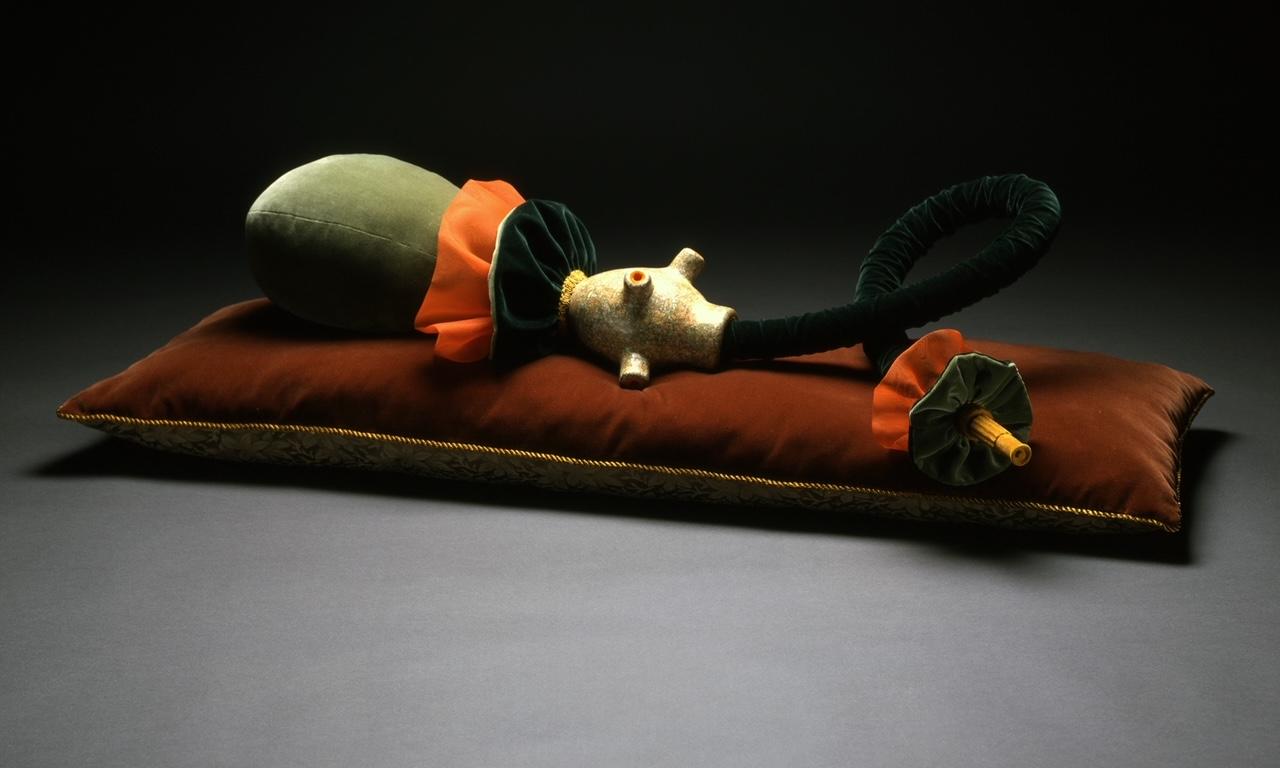
Infanta Margarita
Ceramic, fabric, flocking
9” x 47” x 16”
1994-98
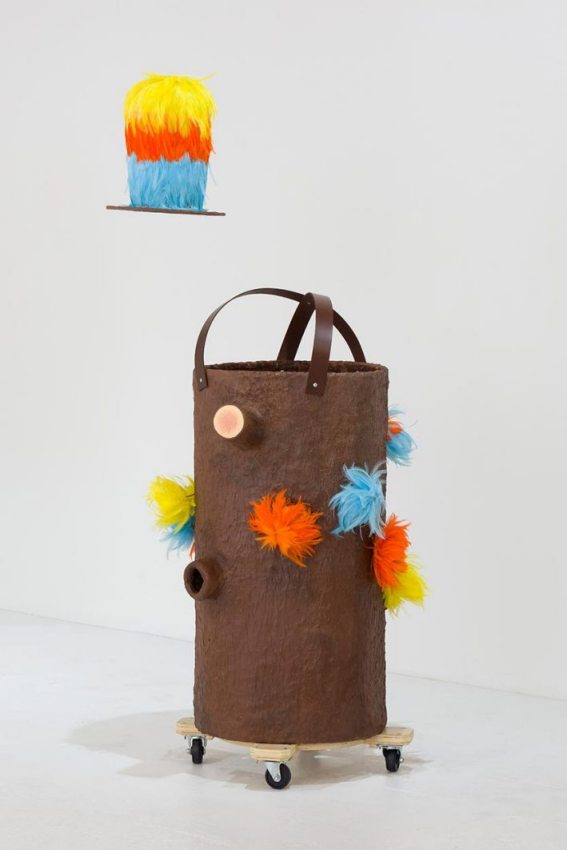
Tree and Birds
Aquaresin, acrylic paint, feathers, fabric, wood
Hat form: 15” x 13” x 13”
Tube form: 50” x 20” x 21”
2017
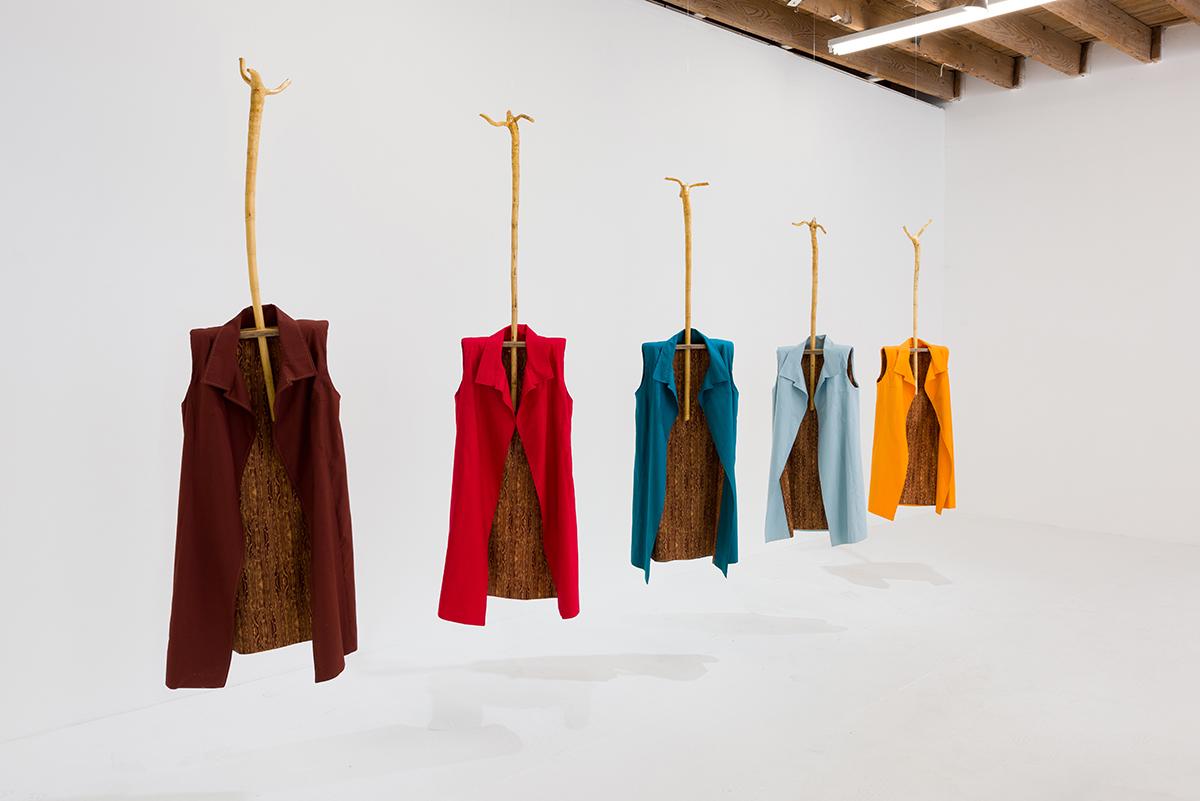
Five Sheaths
Five garments, each 48” x 14” x 4”, suspended on wood rods
Cotton, wood
2017
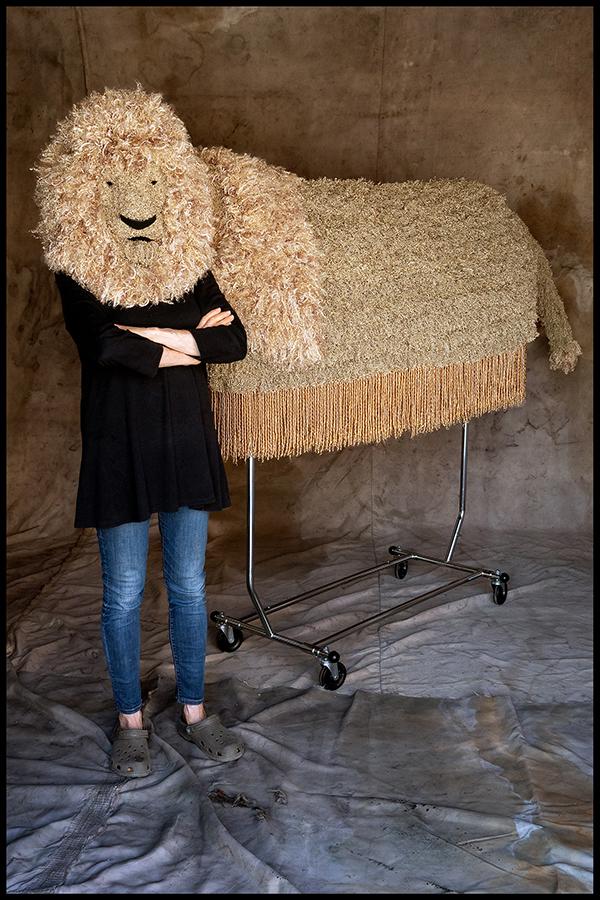
Lion/Lamb
Aquaresin, fiber
70” X 107” X 36
2020
Count Down
Showing: August 30 - October 24, 2021
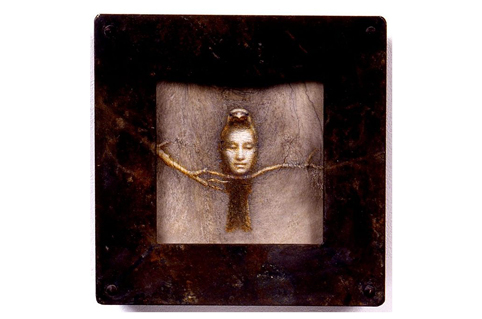
Works by: Adrian Amjadi, Hilary Baker, Phoebe Barnum, Nancy Buchanan, Mary Clark-Camargo, Susan Davis, Lauren Evans, Satoe Fukushima, James Griffith, Gregg Hamby, WS Milner, Cynthia Minet, Lowell Nickel, Sarah Perry, Vojislav Radovanovic, Samuelle Richardson, Nancy W. Romero, Nancy Webber
View Exhibition
All artwork on this site remains the property of each artist. Any unauthorized use of images from this website is strictly prohibited, unless written consent is received from the artist for each artwork used.
Overview
El Camino College Art Gallery is proud to present Count Down, an exhibition addressing global concern regarding the increasing number of animal species threatened with imminent extinction.
Due primarily to actions and practices of unwitting, uncaring or otherwise hungry and desperate human beings, vast numbers of species have already vanished or are on the verge of doing so. There are certainly plenty of arguments on both sides of the questions regarding the possibility of saving animal species versus the process of evolution and the rights of the individual.
Please be invited to make your own choice as to whether you would like to be part of an attempt to rescue the animal kingdom and all that implies, in terms of balance of nature for the health of the planet or whether you prefer to observe the slaughter of elephants as threat to crops and for trophy hunting, whales for meat, tigers, cheetahs and jaguars as threat to livestock, and so on down the long list that descends to the microbial level of being. Take a look at the numerous revelatory films available on Netflix by British naturalist, Sir David Attenborough, including A Life on Our Planet. He, remarkably, is still able to declare that human beings are his favorite animals. In an astonishing gift of positivity, Attenborough offers, despite his vast knowledge of the harm that has already been done, the possibility for slowing or even reversing some of the damage. I, for one, hope that he is correct and will contribute in whatever way I can to this cause. Enough preaching…
Eighteen artists currently residing in Southern California present passionate images in a wide variety of media including sculpture, painting, drawing, video, mixed media installation, digital media and photography, dealing with the progressive extinction of many species of animals. Each of these artists has written a statement about his/her particular works exhibited in Count Down that follows below. El Camino College Art Gallery expresses its deep regret that this moving exhibition cannot be seen in the physical gallery space and is limited to a website exhibition. Please be sure to look at the identification for each piece so that you are able to ascertain the actual size of the image.
Thank you,
Susanna Meiers, Curator
Adrian Amjadi |
|
| Watching our closest relatives fade away... we notice patterns. Our patterns. In struggling to understand our current situation and our future path we forget the sensitivity to the initial conditions of biological networks. We postpone and question means of resolution, but the pattern continues. We know the constants to which we attribute seemingly infinite chaos, but we don't know when. We are ultimately unaware of our absolute chronological position, yet we allow the continuance of these patterns. Blinded by simple and seemingly simple systems we become ignorant to the deep complexities they create. Rarely are we privy to the complete initial conditions... ...except we notice our patterns. We know many of the conditions of our environmental footprint. So why wait for any particular demise, any articulated chaos? |
Adrian Amjadi |
Hilary Baker |
|
|
I grew up in post-war Los Angeles watching a landscape of orange trees and ocean views morph into an urban grid tricked out with freeways, movie studios and industrial buildings. The Los Angeles of my childhood has never been more intricately woven into the Los Angeles of the present than in my latest body of work, Predators. The title refers both to the predatory nature of our local wildlife, as well as the threat by developers of the loss of their habitats. In Predators, graphic depictions of wildlife are presented among a variety of historic locales. I consider my Predators portraits and present them straightforwardly. My urban dwellers position themselves at the forefront of the canvas. Their gaze is oblique. Their confrontation with the viewer is unflinching, and their presence – like the past – uncompromising. It might be argued that these mostly nocturnal creatures serve as stand-ins for any city resident (or at least this artist) attempting to co-exist with a disappearing homeland. |
Hilary Baker |
Phoebe Barnum |
|
 Phoebe Barnum Phoebe BarnumTranscendence 4 mixed media 11" x 8½" 2019 |
The Salton Sea is a land locked body of water that was created by accident in 1905 when water from the Colorado River was diverted for an irrigation system and ultimately became a 400-square-mile body of water with no outlet to the Pacific Ocean. The Water has either evaporated or seeped into the soil that has caused an extremely high toxic saline content. The fish can't survive the conditions and consequently the entire shore is strewn with fish in the throes of dying and decaying. The beach is made of sun-bleached bones, the "sand" is crunching vertebrae. The dramatic play of light and shadow on the fish skeletons is remarkably beautiful. The name for this series is “Transcendence” exemplifying the life cycle of the Salton Sea. |
Nancy Buchanan |
|
| Portraits from No One’s Ark (2006 - present) Each animal has a unique format and/or medium, in order to stress that all creatures are very individual. Scientists are still uncovering new information about the natural world—as it continues to disappear. For example, it seems clear now that zebra stripes are a defense against biting flies—the markings seem to “dazzle” them, so zebras have far fewer flies than other ungulates. The harmless pangolin can consume enough ants to keep a rubber plantation safe, yet these gentle creatures are still illegally harvested for their scales. In research for this series, I have continually found that habitat encroachment and other human actions are responsible for extinction. My hope is that the tightly-knit fabric of the planet might still recover, at least partially. https://nancybuchanan.net/ |
|
|
Nancy Buchanan |
|
 |
Nancy Buchanan So Unjust Stories: Pangolin and Tiger Join Forces A PDF document of this piece can be viewed at the link below: So Unjust Stories |
Mary Clark-Camargo |
|
|
WE WILL NOT FADE AWAY 2020 In Mexico, their presence has a deeper and even more beautiful meaning. These butterflies return to Mexico on Nov. 1 and 2, el Día de los Muertos — the Day of the Dead — when tradition holds that the Monarchs are the returning spirits of loved ones who have died. Monarchs are threatened by deforestation of their habitat in Mexico, disruptions to their migration caused by global warming and poisons that kill Milkweed, a flower that is important to their survival. Their numbers are dwindling rapidly. This piece represents the fragility of our deteriorating eco system, which is supposed to support a tiny being as delicate as a butterfly and the futility of time slipping away from us. If the Monarch represents our loved ones returning to comfort us, who will save her ? Do the spirits know? Do the butterflies know? |
Mary Clark-Carmargo |
Susan Davis |
|
|
19th century periodicals and journals documented the degree to which global imperialism changed the planet. Engraved illustrations were the mass media of their day and critical to extolling the virtues of Western dominion over foreign cultures and the natural world. I find these images to be beautiful and foreboding at the same time. They document an age in which we assumed control over the habitats of creatures deemed to be both exotic and exploitable. I also see humor in their earnest depictions of an era that seriously overestimated its own virtues. I subvert these engraved images and their original intent with irony by combining and re-contextualizing them in a digital format. The animals used in my pieces are recognizable as endangered through scientific study and media exposure but the spider in several of my images is not readily known as an endangered species. I use spiders in two ways – as a metaphor for the insect/animal world trapped by human aggression and as a species that is reviled by many while also in peril. “The Nature Conservancy, in cooperation with the Network of Natural Heritage Programs (NHP) and Conservation Data Centers, maintains one of the most comprehensive biological databases in the Western hemisphere. This database includes global, national and state conservation priority ranks (Master 1991). Only 114 spider species are being tracked in these databases, with 57 assigned priority ranks, clearly illustrating the lack of compiled information on the status of spiders. Of these, 40 species are considered of national concern, with 29 species considered imperiled or critically imperiled (The Nature Conservancy 1997). The other 11 species are considered rare and not necessarily imperiled, but six of these have some uncertainty regarding their status.” Source: University of Michigan Technological advancements from the past and accelerated destruction of habitat in our own time endangers species and nearly guarantees their demise – to their great peril and ours. I thank the New York Public Library's Archival Resources for the source materials used in these digital photo-collages. Susan Davis https://www.instagram.com/p/CS-RdwwhSGp/?utm_medium=copy_link |
|
|
Susan Davis |
Lauren Evans |
|
|
Welcome to the Rhino I like to use repetitive units requiring repetitive tasks such as casting and glazing hundreds of Rhino tiles or gluing hundreds of ping-pong balls or by creating multiple colored pencil shavings. Repetitive activity can be both frenetic, like racing thoughts, or meditative, like repeating mantras. The series “Welcome to the Rhino” was the first series when the Rhino entered my work. It was a time of turmoil both personally and in our country. Facing my own demons felt like a Rhinoceros breaking through my chest. This image sparked the work. The series includes seven relief sculptures hung around the space like a circus parade. The Rhinos lumber up and down in a whimsical but awkward way. |
|
|
Lauren Evans |
Satoe Fukushima |
|
|
“Helium is the only element on the planet that is a completely nonrenewable resource.”
It too is in the realm of potential future over-use and extinction. Its unique characteristics have been used in medical and industrial setting; MRI to quantum computing as cooling agents or non-flammable shielding agent. It is an element we highly depend on in order to have technological advancement and party decorations. Helium balloons can become too expensive to decorate the parties someday. About the Artist Satoe Fukushima earned her MFA in Fine Art and Integrated Media from California Institutes of the Arts in 2013. Her art often deals with the gaps of language and its transmitted information; these gaps concern not only verbal communication, but also cultural agreements and disagreements. Fukushima uses a wide range of media including bread, video, sculptures and whipped cream, and humor in desperation. Intentional miscommunication is often part of the mix. Satoe Fukushima has exhibited, curated and performed at various venues both locally and internationally, including the Barbara and Art Culver Center of the Arts, LA Municipal Art Gallery, Artists’ Union Gallery, California Institutes of Arts, California State University Long Beach, Otis College of Art and Design, El Camino College Art Gallery, and Huashan Creative Park in Taipei. |
|
|
Satoe Fukushima |
James Griffith |
|
|
One of the goals of my paintings is to raise the question of the presence of sentience and emotions in all animal life. I believe in the equal value of all living beings. This is a very inconvenient idea. As humans have come to dominate the entire planet by developing the advantages of agriculture, architecture, weaponry, massive population, and other technologies, we have institutionalized our power over other species so that we cannot easily give up our mantle of self-proclaimed superiority. Now, although the lives of every living being on earth is at the mercy of human choices, we as individuals have very little power to save another species. We must act in groups and coalitions to preserve the diversity of life needed to survive changing conditions and altered ecosystems. Humans are creative and inventive enough that we might actually succeed in postponing the worst of the Sixth Extinction. However imagination is a double-edged sword: Humans have a unique capacity to believe in imaginary realities and to behave as if the actual facts of our existence do not apply to us. The desires of our egotism and our false superiority may bring us all down. My response to this dilemma is to try to resist the easy tendencies toward human egotism in my personal life, to support ecological equality any way I can, and to paint these images to inspire others to regard all life as magnificently beautiful and valuable to us all. James Griffith, 2021 |
 James Griffith James GriffithOkapi tar on canvas 58" x 42" 2018 |
Gregg Hamby |
|
|
Animal Spirits There was once a time when it was Man & Nature. When we knew our place and treated
nature with respect and reverence. The earliest instance of It is in the tradition of the Native American’s honoring of the animal spirit, that I create my art as one-of-a-kind original drawings. Each drawing is in recognition of the animal’s innate talents and is meant to be a gift and a teacher to those who have made a spiritual connection with the animal. In much the same way as the Native Americans, my goal is to use my art to continue to pass down stories, ideas and believes that reflect our continued connection to animals and the natural world that surrounds us. “One thing to remember is to talk to the animals. If you do, they will talk back to you. But if you don’t talk to the animals, they won’t talk back to you, then you won’t understand, and when you don’t understand you will fear, and when you fear you will destroy the animals, and if you destroy the animals, you will destroy yourself.” ~ Chief Dan George, I believe, if I can personalize nature in a way that will make people want to take better care of and empathize with nature and animals more then we can take steps towards a better relationship with the Earth, like that of the indigenous tribes of the Americas.
Additional statements for individual pieces by Gregg Hamby can be viewed at the COUNT DOWN: ARTISTS' STATEMENTS AND IMAGES link. gregghambyart.wix.com/gregghamby https://www.instagram.com/gregghamby/ |
|
 Gregg Hamby Mountain Ghost - Snow Leopard pencil drawing 63” x 28” |
WS Milner |
|
 WS Milner WS MilnerWe Are All The Same wood, dried devil’s claw seed pod, polymer clay, acrylic epoxy, acrylic and oil paints 6-20" x 4-10" diameter |
We Are All The Same is WS Milner’s illustration of our deep, ebullient, if you will - animal selves, the
essential lightness of being which is who we are long before gender, ethnicity, family,
community, religion, or politics. These better angels are us regardless of our backgrounds.
Created as a self-tutorial in 2019-2020, my intent was to undo the personal, psychic
damage of living in an unconscious and polarized America where |
Cynthia Minet |
|
|
Unsustainable Creatures: Elephant, 2013 More About the Elephant: |
|
|
Seconds to Last, 2021 The artist's first inflatable sculpture, Seconds to Last, depicts the nearly extinct Northern White Rhinoceros: there are only two surviving members of the subspecies on Earth. In a nod to her most recent work, which focused on both human and animal migration, Minet utilizes repurposed camping tents sourced from her neighbors' visits to the Burning Man festivals. As our cities fill with people living in tents, the result, in part, of our profit-based economy, so too does the rhinoceros face extinction, due to poaching and loss of its habitat. The sculpture is lit by LEDs whose colors reference the seven energy chakras. Presented in a darkened room at the museum, the project's sequenced lighting slowly extinguishes before the viewer, until its presence is only sensed in darkness. Seconds to Last can be viewed online at the following link: |
 Cynthia Minet Seconds to Last (inflatable) repurposed camping tents, sequenced LEDS, rope, lead weights, fan Lighting Design: Vaughn Hannon 60" x 120" x 64" 2021 |
| http://www.cynthiaminet.com | |
Lowell Nickel |
|
|
This digital art making images can be associated with what has recently been labeled as the “Anthropocene”. The term Anthropocene or Holocene Epoch begins when human activities started to have a significant global impact our earth's biology and ecosystems. The basic concept of these axe heads can be strengthened as a perceptible iconic symbol… these are long lived (double edged) tools. The “clearing of the land" was once necessary but we now find limitations by recognizing earth as a biome. Over time, when the weathering forces of nature serve as the ultimate liberator of all human creations, the flora & fauna will again develop fully and richly. These artistic investigations are mixed media, i.e. Slab built Ceramic axes (7”x12”) then photographed and used in digital compositions that can be printed any size. |
|
 Lowell Nickel Axes Comp mixed media slab built ceramic axes with branches 7" x 12" |
Sarah Perry |
|
|
Speak for Me, 2004 Additional statements for individual pieces by Sarah Perry can be viewed at the COUNT DOWN: ARTISTS' STATEMENTS AND IMAGES link. |
 Sarah Perry Sarah PerryThe Meek aluminum grate, altered shed cicada skin abdomens, silicone 20½" x 11" x 3½" 2009 |
Vojislav Radovanovic |
|
|
Wanderers is an audio-video artwork by Vojislav Radovanovic in collaboration with composer Joseph Carrillo. This work is about grief and anxiety for the growing climate crisis and the sixth mass extinction-level event that our planet is currently experiencing due to human impact. The video tells the story of the two last surviving birds flying through a desolate landscape of a burned forest, as told by a human puppeteer (performed by Jason Jenn), suggesting that the action is taking place in a barren future where there is little other life in existence. The use of some repetitive sequences is a reference to looped social media videos, a popular visual style we have grown accustomed to in this human-influenced Anthropocene era. This piece can be viewed online at: |

Vojislav Radovanovic Directed by Vojislav Radovanovic |
Samuelle Richardson |
|
 Samuelle Richardson Samuelle RichardsonGhost Dogs 2 mixed media 4' x 7' x 4' |
Ghost Dogs There was a buzz of excitement that morning. A rare pack of African Wild Dogs had been sighted in the area as we rumbled off into the bush hoping to find them. At last we did and with hearts pounding, inched closer as they locked eyes on us. I stood transfixed as I watched their kaleidoscope of dappled fur on stiletto legs, jostling and head-butting like a kinetic sculpture. Then they gathered to move on, and aching to prolong the moment, we followed them until they disappeared into the mist. The Ghost Dog sculptures are handmade armatures of tree branches and found materials that include wire, wood, paint, foam rubber and wool sweaters. Samuelle Richardson, 2021 |
Nancy Romero |
|
 Nancy Romero Nancy RomeroTiger tempura on clayboard 6" x 6" 2020-21 |
Fooling around in the studio during COVID isolation, I made a couple of small tempera
paintings of animals around me . Normally, most animals will not directly look at
you because it is confrontational .The eyes from the frontal position of these faces
seemed to follow me and say j’acuse. The power in the gaze challenged me to develop
this format to speak to the loss of habitat and diminishing numbers of animal species
around the world. Ultimately I made 46 portraits that I hung together for mass effect.
This collection of faces is a selection from that work. |
Nancy Webber |
|
|
Recent work from four murals commissioned by the Los Angeles Department of Cultural Affairs for the Harbor Animal Care Center in San Pedro and the drawings of endangered species/animal portraits, is concerned with my love of animals. These are rendered from digital photographs, in pastels and colored pencils and are intended as an awareness and appreciation of the planet’s variety of wildlife now at risk from global warming, loss of habitat and human greed. As my “Life imitates Art” photographs was an ongoing series begun in 1979 continuing until 2015, this series of drawings, is ongoing due to the persistence of factors related to the disappearance of animal species. |
|
 Nancy Webber Orangutan and Infant. Mountain Gorilla with Baby graphite and colored pencil on paper 18” x 24” 2021 |
There are many organizations world wide devoted to environmental and wildlife issues. See below for a short list of four of the most well known in the U.S.
- World Wildlife Fund: WWF Endangered Species Conservation
- Environmental Defense Fund
- The Nature Conservancy
- Greenpeace
|
El Camino College Art Gallery is pleased to present works from the students of El Camino College Art Department, Spring 2021. The majority of the work has been produced during the online season of classes taught during the COVID-19 pandemic. The college is particularly proud of both the students and the instructors who have persisted throughout this stressful period and who have succeeded in creating admirable examples of artwork . All artwork in this exhibition has been selected by the instructors of each of the studio classes, awarding two outstanding students within each section, placement in this online show. The annual Student Art Exhibition includes a variety of art works fabricated from a wide range of media. The show provides a unique glimpse into the educational and an aesthetic philosophy advocated by the El Camino College Art Department and illustrates a diversity characteristic of the contemporary art world. |
Melissa Davis (Left) Kassie Simons (Top Center) Katie Masciotti (Bottom Center) Roanne Kim (Right)
|
|
Despite an occasional departure from tradition, the majority of the works in the exhibit are grounded in an academic approach to art study and training. Represented in the exhibition are traditional two-dimensional painting media (oil on canvas, acrylic on canvas, watercolor on paper) as well as drawing media on paper (graphite, charcoal, pastel and Conte). Printmaking techniques include linoleum block, lithography, etching and screen printing (serigraphy). The computer design classes produced video animation as well as photo-based laser printed graphic designs and illustrative pieces. The animation is available to view by clicking the designated links. Additionally, the show includes a cross section of traditional three-dimensional techniques taught in the department -- jewelry construction; wheel thrown and slab-constructed clay vessels and hand-built objects as well as a variety of mixed media constructions. The Student Show may be characterized by an energy and vitality unique to emerging artists. Please join us in celebrating the creativity, talent and tenacity of this particular group of artists. |
|
2021 Student Show Online Slide Exhibition
Myriad 2020
Design & Production by SP 20 students of Art 143 Digital Publishing Fundamentals
Perfect bound book, Color Cover, BW pages, 5.5"x8.5"
Tense
Design & Production by SP 20 students of Art 143 Digital Publishing Fundamentals
Perfect bound book, full color, 7"x7"
Price: $19.31 + shipping
El Camino College Digital Arts YouTube Channel
Animations by students of:
Art 141 Digital Art Fundamentals (multiple sections)
Art 144 3D Modeling & Animation
Art 145 Web Animation and Games
Art 147 Motion Graphics
Statement and Study Guide PDF

Artist LAUREN KASMER will present a series of unscripted LIVE STREAMING PERFORMANCES and film screenings as part of her virtual solo show “MOMENTA” on MAY 1 and 2
Watch live on LaurenKasmersMomenta.com
Live performances include readings, dance, movement, tai chi, a story time, guided meditation, and spontaneous interstitial episodes – Kasmer’s films will also be looped onscreen
An exhibition in five parts, Momenta comprises: Mount, a video; Wardrobe, photographically printed wearables; Equipoise, an installation with activation; Collaboration at a Distance, photography; and Flourish from Fire, documentary images
During the Live Streaming Event there will be a limited edition Viewmaster giveaway
A COMPANION BOOK will be released in June 2021
Performance schedule is below





LAUREN KASMER - MOMENTA: Online Exhibition
MOMENTAAn online exhibition
|
 Mount Video Still 9 2019-2020 Video Still Dimensional variable |
Due to the technological limitations of the ECC website the exhibit, Momenta will be available to be viewed on a website www.laurenkasmersmomenta.com created specifically as a new form of art exhibition. Please watch this site for
upcoming details regarding exhibition related events.
El Camino College Art Gallery is pleased to present the work of Lauren Kasmer in an
online solo exhibition, Momenta. Lauren Kasmer is a multi-disciplinary artist who
has worked extensively in photography, textiles, installation and video. She has also
curated shows in galleries and in multiple alternative spaces. Her background includes
a degree in design from UCLA and an early introduction to clothing design as the daughter
of an American fashion designer. Early on, Lauren decided not to follow in the commercial
footsteps of her mother but rather to approach clothing from a personal standpoint.
She incorporates her photographs into digitally printed sensuous wearable art that
acts as an element in of each of her installation/performance projects and video works
over the last ten years.
Momenta is comprised of five segments: Mount, a video; Wardrobe, photographically printed garments; Equipoise, an installation with intended activation; Collaboration at a Distance, photography; and Flourish from Fire, stills of the Blind Courier exhibition installation project, presented at the Brand Library in 2019. When link
is available, please click on still photographs presented in grids throughout the Momenta exhibition to view the expanded images.
Mount
In this context the title refers specifically to the surmounting or overcoming of
an obstacle and to the geologic formation, mountain.
Mount is a poetically charged, non-narrative video originally intended for exhibition in
the context of a multi-media gallery installation. It is a visually layered piece
that reflects on a devastating fire that engulfed Kasmer’s home, destroying not only
much of her artwork but literally altered her past and present. Additionally Mount addresses the wildfires that have recently ravaged California and Oregon and tackles
the overall climatic impact of man upon nature, along with the imperative that humans
must develop an essential respect for the natural world or perish.
Through the exclusive use of female actors and models in natural settings throughout
Momenta, one senses an inference by the artist that the feminine or receptive mode
of existence is potentially a route to a global healing.
“As our collective and personal lives are impacted by external elements I find that
the connection to nature becomes the grounding vehicle for healing and new growth.
What grows from ash is an inspiration for personal recovery, creativity and seeds
new ideas, stories, and explorations. A force majeure causes one to reach for beauty,
contemplation and a return to an internal Eden.”
- Lauren Kasmer
Film composer Jennifer Ricciardi has worked in tandem with visuals by Kasmer to create
liquid arrangements of electronically synthesized sounds pooled with sounds captured
in nature to underscore both the Mount video and the Activation cycle of Equipoise.
| Wardrobe On view is a collection of the garments made of the artist’s digitally printed photographs on fabrics, sewn into wearable clothing. These wearable art pieces have been shown with Kasmer’s installation projects spanning the last ten years. The garments contain imagery pertaining to the individual installations- i.e. bee/hive imaged clothing was a component in a project that dealt with honeybees. Frequently the artist’s imagery contains native plant life and forces of nature. The hand-painted hangers and small tufted rugs were made in 2020, partially stimulated by the urgency and isolation generated by the Covid-19 pandemic. Her up-cycled Sitting Rugs are produced from the shredded remnants of her digital fabrics. |
 Wardrobe Detail 2020 Documentary photograph Dimension variable |
| Equipoise Equipoise: 1: a state of equilibrium. 2: counterbalance. Housed in an apartment bedroom, Equipoise is Kasmer’s current installation, presented in an alternative context. Her original intent was to open this thoughtful environment to an invited public, however, the global pandemic intervened. As the Covid time period of necessary self-isolation extended, this space morphed into a meditative chamber with sacred objects, ritual instruments and rugs, intended for the practice of meditative sitting. The artist has a serious practice of meditation and deep interest in the therapeutic properties of specific minerals as well as the potential healing influence of sound. This installation intentionally combines the artist’s history, through use of clothing hanging in the closet and projected images from her videos with her meditation practice. The Activation segment of Momenta is intended to demonstrate not only her own artistic sensibilities but also to suggest a possibility of what individuals can privately create as a contemplative space within their own environment. |
 Equipoise Installation Activation 10 Equipoise Installation Activation 102020 Documentary photograph Dimension variable |
| Collaboration at a Distance Lauren Kasmer Digital photographs on textiles; 2010-2020 Photographers: Chandler Kennedy, Chris Kennedy, Monthira Soonthorsarathool Models: Gabriella Ortega, Leilah Franklin, Natasha Nunez, Cody Kennedy, Emily Rosenstein, Satoe Fukushima, Cilka Mark Lauren Kasmer temporarily moved out of the Los Angeles area mid-Spring, 2020. She continued her work on the Momenta exhibition via Zoom, Skype and email to create an impressive collaboration with ten women friends who intermingled to model and photograph each other, wearing and interpreting ten years of an archive of Kasmer’s photographically printed wearables. |
 Cilka 11 (multi) Cilka 11 (multi)2020 Photograph Dimension variable |
| Flourish From Fire Lauren Kasmer's Flourish From Fire, is an installation composed of two poetic non-narrative videos surrounded by domestic furnishings and photographically based wall works whose photographic imagery is sourced from a devastating home fire. The arrangement is an inviting space, a reinterpretation of shelter, one that proposes that what can be seen as personal tragedy could instead welcome contemplation and reflection of universal themes. The barn's burned down: now I can see the moon. Mizuta Masahide |
 Flourish from Fire Installation View 5 Flourish from Fire Installation View 52019 Documentary photograph Dimension variable |
Black Lives Matter Online Exhibition |
|
BLACK LIVES MATTER:An online exhibition of works by 31 artists in response to the killing of George Floyd and the ensuing protests. Work by: October 1, 2020 - January 3, 2021 ONLINE EXHIBITION ONLY Go to elcamino.edu then type in Art Gallery |
|
In June, 2020, incensed and saddened by the murder of George Floyd by the Minneapolis
police and heartened by subsequent nation-wide protests, it seemed essential to provide
a public platform for artists to respond to the issues surrounding Black Lives Matter.
At the same moment I contacted Dr. Russ Ellis, a professor whose class titled “Niggers,
Negroes and Black People” I had attended in 1967 at Pitzer College. My initial reason
for contacting him was to thank him for the class that was to permanently affect my
thinking. When I asked Dr. Ellis if he had any lectures online that might be used
in tandem with this exhibition he suggested that I pose a series of questions instead.
The questions and Russ Ellis’ responses follow.
As a brief introduction: Russell Ellis is a visual artist, musician and educator.
He went on from teaching at Pitzer College in Claremont, CA to teach in the Department
of Architecture at U.C. Berkeley where he later became the Vice Chancellor of the
University. He simultaneously worked as a sculptor in both metal and stone and later
trained as a painter. Please see his bio that follows the question/answers.
I want to thank Russ Ellis for his willingness to engage in this process of questions
and answers and again for his initial class. Also, thank you to the more than 25
artists who take the subject of racism and Black Lives Matter very seriously and respond
through their artwork in a broad array of approaches and medias ranging from painting-both
figurative and abstract, sculpture, drawing, performance and mixed media installation.
- Susanna Meiers, Art Gallery Director/Curator
Susanna Meiers: Given that you are a visual artist and educator and the fact that
this is a website for a college gallery, what do you think the role of the arts
might best be during this time? And the role of classes taught within an Art Department?
Russ Ellis: I think my background qualifies me to hazard a modestly informed response
to your question. However, indulge me while I enter my response through a side door.
A few years ago I accompanied my art class instructor, painter Katie Hawkinson and
her husband, sculptor Joe Slusky, to a joint showing of their work at Stanford University.
To my surprise, their work was spread across three campus sites: Center for Integrated
Systems, Electrical Engineering, and the psychology Department. The art was scattered
among lobbies, conference rooms, laboratories through the windows of which active
research could be seen in progress.
In one lobby, I encountered a young man who had set up several interacting computers
processing images of various sorts. I asked him about his project. As he was describing
it to me he reminded me of applicants to UC Berkeley’s Ph. D. program in architecture.
Wildy brilliant, intellectually unmoored, confident to a fault. I failed to understand
his explanation of what he was demonstrating, but he clearly felt at home and I felt
him to be at home.
This was 2014. I was unaware of Stanford’s Arts Initiative launched in 2006. <https://arts.stanford.edu/about/> But later, reflecting on the whole experience, I thought Stanford understood something
fundamental about human inventiveness; keep art intertwined with everything.
Stanford is securely endowed. Community colleges, state colleges and universities
are not. But, to the extent possible, I think we should all struggle to keep art
intertwined with everything curricular. Whatever may be dominating the public attention
at the moment.
I know nothing of art pedagogy, but I’m guessing that burgeoning artists will, as
ever, come bursting with improbable impulses. As ever, the instructor/guide’s job
will be to respond inventively to those impulses; especially leaving them be.
In 1967 I attended your seminar at Pitzer College in Black Studies. If you were to
teach a course now, in light of the current extremis and potential for new understanding,
how might you structure it?
The class you took from me in 1967 was titled “Niggers, Negroes and Black People.”
The goal of the course was to examine race relations from the standpoint of the evolution
of how a people are named. That was being publicly contested at the time, as it continues
to be today.
Pitzer College had been formed in 1963. It’s initial student market was middle to
upper-middle class women. In 1970 it went co-ed. I was on the faculty from 1966 to1969.
There’s no doubt that I chose to use “Nigger” in the class title in order to break
open delicate sensibilities. (Course titles at Pitzer tended in that direction. My
wife taught a demography class she titled “Hatched, Matched, and Dispatched.” Ellen
Ringler taught an English literature class she named “Hell: A Survey.”)
I did not choose a career trajectory that expanded my expertise in race relations.
If I were to teach that course again, I would definitely not title it “Africans, Niggers, Nigras, negroes, Negroes, black people, African-Americans, People
of Color, and Black people.” (Although that could be the bones of a course outline).
The learnings about naming and the struggle for the name of a people are exportable
over time and space, especially in this nation of immigrants. I would cover the same
terrain today. Now, it would be a two-semester course.
“What Next?” is the phrase in the minds of most people who are invoking change in
the prevalent culture of racism. Would you be willing to speak to this question?
For years I have been mentally framing an essay titled “My Mother’s Racism and Mine.”
It would compare her very hard-wired anti-white sentiments with my fluid, never-ending
struggle to manage my judgements of others and keep them from attaching to categories
like, Jews, Chinese, Mexican, Women, etc. My thought has been that making my relationship
to racist tendencies public might help others think about their own.
We in the United States have chosen to acknowledge, to one degree or another, the
principles of our sacred documents. Freedom, equality, caring for those in need, etc.
For generations, when it comes to inequality, racism and xenophobia, these have been
held as personal responsibilities. That’s what my essay would cover.
But the killing of George Floyd somehow shifted significant public consciousness toward
an interest in “systemic racism,” not the racism of individuals. The necessity of
personal anti- racist work is permanent. Dealing with systemic racism is the answer
to your question, “what next?”
Are there particular questions that you would encourage individuals to personally
tackle in order to further their own consciousness regarding racism?
I’m reluctant to give advice to people I don’t know with pathways in life I can’t
comprehend. Nonetheless, I was recently struck by this haiku:
untitled haiku
because white men can't
police their imagination
black men are dying
-- Claudia Rankine
After 85 years as a Black person in America, I’ve settled into an understanding that
dealing with racism is like freedom of speech, freedom of the press, justice, etc.
Their accomplishment, protection, and improvement is not permanently engraved anywhere.
They are a constant struggle, both socially and individually.
A practice that I have developed over the years is to confront my own incessant judgments with an incessant “why’d you do that?” I’m in a constant conversation
with myself. No one is safe from my leaning toward final judgements and assignments
of behaviors I don’t like to categories.
In the arena of prejudice, I’m quite astonished by my progress with homosexuality,
for example. In my community a “punk” was the lowest of the low. I still have a few
problems, but I am not anywhere near where I was before I got to college.
Managing my relationship to race and ethnicity are, in my everyday life, emotional
and intellectual equivalents of three-dimensional chess where the game never ends.
A constant struggle. Although coming late in my life, five years as Student Affairs
Vice Chancellor at U. C. Berkeley was indelibly educational.
Hurtful mistakes, unplanned breakthroughs, constant attention seem to have accumulated
into some small form of wisdom and improved life practices for me. Constant attention
can be fatiguing. But there are rewards. And it’s better than relaxing into the cultural
drift. It can be rewarding to stay a constant participant in your own becoming.
As destructive policing appears to be the symptom rather than the root of racial power
politics, how would you imagine beginning the re-education of the American public?
After fifty years in and around higher education, my first thoughts spring from those
experiences.
When you took that class from me in 1967 U. S. higher education was struggling with
the academic accommodation of Black Studies. Pitzer actually did not have Black Studies.
Just my class.
For years the U.C. Berkeley faculty struggled with whether or not to make ethnic studies
classes a curricular requirement for undergraduates. In 1991, a thoroughly negotiated
solution was the creation of a program called American Cultures. <https://americancultures.berkeley.edu>
Upon close inspection, this is not exactly an ethnic studies requirement. But it encompasses
and expands the domains of interest. I think now is the time for higher education
to look closely at the possibilities of such programs. This is especially relevant
because colleges and universities are where other aspects of systemic racism are touched
on; economics, political science, business, sociology, health care, justice, demography.
If an individual has had negative experiences in their history with someone of another
race how does one overcome the racial supposition that all people who are of another
color are suspect?
I am less racist than my parents were. My children are less racist than I am. My grandchildren
are the least racist members of the family. Progress is possible; in individual lives
and over generations.
I am Black. I have friends who are not Black who have had bad experiences with Black
people. I still have white friends and I have had a load of bad experiences with white
people over the last eighty years.
I will never be fully free of my prejudicial impulses. It’s a constant struggle. My
hopeful fantasy is that I walk in a world of people dedicated to the constant struggle.
2020 Bio for Russ EllisI was Born in Los Angeles in 1935. During WW II, I lived on a farm in Fontana, California. The KKK were vigorously represented in Fontana. After the war I went to live with my father and step-mother in a new house purchased in the George Washington Carver Manor Annex at the southern end of Central Ave. in Los Angeles. A track scholarship to UCLA from Compton High School paid for my college education. Two years after graduation from UCLA, I returned to its graduate program in sociology where I earned a Ph. D. I married my fellow graduate student, Judith Fairston, here from the London School of Economics. We had two children. I have had teaching appointments at The University of California, Riverside, Pitzer College, The State University of New York, Old Westbury, Yale University, and The University of California, Berkeley. The latter appointment was in the Department of Architecture of Berkeley’s College of Environmental Design. There, I dealt with social issues in architecture and urban design. My last five years at Cal I served as Vice Chancellor for Undergraduate Affairs Upon retirement I continued my untutored practice of stone carving until I hurt my back. I turned to modeling clay and bronzes for a while, but that gave way to painting. I have had several local shows and had the support of a wonderful painting teacher, Katie Hawkinson for ten years. See also <poopah.net> Last year I stumbled, accidentally, into song writing. With the help of my children and their friends in the music world, I have completed an album of about eleven tunes called Music From The Garden. It can be found at Berkeley Cat Records (Russ Ellis). |
|
There are also two additional video links provided for Russ Ellis:
Chika Ding - (Change That)
Chika Ding is a collaboration between Poopah McVout aka Russ Ellis and Alcide Marshall.
Enthisic celebration of American Democracy. Especially the VOTE!
This video piece can be viewed online at:
https://www.youtube.com/watch?v=ZknpbwCFTYQ&t=31s
Oom Chugga (Remix)
(feat. MicBlake feat: Chris Burger for Panther Fist Studio/PFS)
This audio piece can be listened to online at:
https://russellis.bandcamp.com/track/oom-chugga-remix-feat-micblake-feat-chris-burger-for-panther-fist-studio-pfs-2
Black Lives Matter Online Exhibition
An Acrobat PDF document with the Artists' Statements and Images from the exhibition
can be viewed or downloaded from the link below.
Black Lives Matter: Artists' Statements and Images
In addition to the artwork shown in the sldeshow, several artists' work is available
either in Acrobat PDF documents or in online media presentations. Those artists' works
are below.
Garrett M. Brown

Garrett M Brown; Candlelight Vigils #9...
Candlelight Vigils # 9...Passing An Orchard By Train...by Robert Bly.
In Memoriam, GF.
This video piece can be viewed online at:
https://drive.google.com/file/d/1rm12_waS7HPFvNLSrmaLv1wsHt9vgHRO/view
Satoe Fukushima
 Sotoe Fukushims; Relax, Panic, Eat... |
Rosa Park’s Pancake Recipe Featherlite Pancakes Put together 1C flour 2T B.Powder 1/2t salt 2T sugar Mix 1 egg - 1 1/4C milk 1/3C peanut butter 1T melted shortening or oil Combine with dry ingredients Cook at 275° On griddle Adapted version 1C All purpose GF flour 1 1/2T B.B.Powder (use less if the GF flour has B.P.) 1/2 t salt 2T beets sugar 1/4C unsweetened Applesauce 1C alternative milk 1/3C Coconut oil with 3T Kinako (ground roasted soybean) 1T coconut oil Cook as directed in the original recipe. |
Relax, Panic, Eat...
It is not only a delicious tradition, but also it gives an opportunity to talk about
her courageous action and its meaning for change. America is still suffering the
same racial disparity and it became more visible thanks to the technology. We are
finally sharing the long sufferings of Black lives and cries for change. We all need
Rosa's motherly side to carry on this painful movement to punch through the intolerance.
It's okay to panic and cry a bit, but eat breakfast and get ready for action.
This performative audio piece can be listened to onlne at:
https://www.dropbox.com/s/1abj7ws2kqmuki3/BLMRosaParksPancake.mp3?dl=0
An acrobat file for the Rosa Parrks Pancakes recipe can be downloaded from the link
below:
Rosa Parks Pancakes
Yrneh Gabon
 Yreneh Gabon; Diversity in the University
Yreneh Gabon; Diversity in the University
Diversity in the University
This video piece can be viewed online at:
https://drive.google.com/file/d/1BdH_qUEbAY2-Qs_E81U8c2NTLzvOxqZy/view?usp=sharing
Joyce Kohl

Joyce Kohl; Remembering Jeremiah
Remembering Jeremiah
This powerpoint presentation can be accessed online at:
https://drive.google.com/file/d/1HhU_oFFqvoDbbTQ7v148MfJFR9W3j00t/view
Margaret Lazzari
 Margaret Lazzari; Start, Flow, Restart
Margaret Lazzari; Start, Flow, Restart
Start, Flow, Restart
Start, Flow, Restart also is a video of my process in making a watercolor painting. In this case, I needed
to use video not to show raw emotionality as with Conflict. Rather, I used its the
time-based linearity to show the cycles of building/obliterating/restarting. So much
political activism is basically fighting the same battles over and over again. The
ground under foot always seems to be dissolving away. Start, Flow, Restart was for
me an act of faith that progress will be made.
This video can be viewed online at:
https://www.youtube.com/watch?v=JZZ4-8CPTBk
 Margaret Lazzari; Conflict
Margaret Lazzari; Conflict
Conflict
Conflict was made after a political fight with a family member, which left me feeling very
angry and outraged. I made this mixed media watercolor with splattering marks, gritty
charcoal, and scraping pencils that built up on and tear away at the paper. In this
case, a finished watercolor is too static to show the energy and emotion that went
into this work. Therefore, I recorded my process and edited the video so that it
had jarring cuts and staccato rhythm.
This video can be viewed online at:
https://www.youtube.com/watch?v=A_8cvU2DgwA
Peter Liashkov and Don Saban

Peter Liashkov and Don Saban; Strange Fruit
Strange Fruit
The STRANGE FRUIT project was conceived after doing a residency at Pike school of
Art in Mc Comb , Mississippi. I gathered documentation and photographs dealing with
the legacy of slavery & lynching in the Southern United States & soaked up the haunting
atmosphere of the countryside as seen through the eyes of photographer, Sally Mann.
This resulted in a body of work that included a series of multimedia paintings ,
short videos & an installation of a tree branch superimposing a series of small prints
in a grid formation . My good friend, a prominent L.A . photographer, Don Saban
was intrigued by these prints & offered to rework them to enrich the color & the spatial
qualities of the images. The addition of the audio of Billie Holiday singing the classic
song, Strange Fruit, seemed to be appropriate to evoke the deep sorrow imbued in these
works.
-- Peter Liashkov
This collaborative video piece can be viewed online at:
https://www.youtube.com/watch?v=0vtt9QQnQV0&feature=youtu.be
Marianne Sadowski
 Carolyn Kessler Eaton; Justice, from Justice/Injustice ebook
Carolyn Kessler Eaton; Justice, from Justice/Injustice ebook
Justice/Injustice ebook
An acrobat ebook for a printing class project by Marianne Sadowski in coordination
with a LACMA online program can be downloaded from the link below:
Justice/Injustice ebook
Black Lives Matter Study Guide Questions
|
An online exhibition of work by 41 Southern California artists plus one musician in response to the onslaught of COVID #19
Work by: August 15 - September 30, 2020 ONLINE EXHIBITION ONLY |
|
In early March this year, 2020, much of humanity was gripped by fear at the news of a globally transmitted virus of new and astonishingly dangerous proportions. In China, where the virus originated through animal to human contamination, the government rapidly mandated that all citizens completely shut down interpersonal contact beyond the family bubble in attempt to contain the spread. Countries throughout the east and west followed suit as the virus traveled and voraciously consumed lives. Within a fairly limited time span China was able to contain the proliferation of the disease by means of rigid and potentially punitive enforcement of rules of conduct.
In the relatively small, parliamentary democracy of Finland where healthcare is entirely socialized and there is a high degree of intentional cooperation, the COVID 19 has been contained and deaths have numbered 329. Different countries have handled the pandemic in ways that are unique to the cultures involved and suppression of the virus has varied accordingly.
Unfortunately the US has been hard hit by the disease due to a variety of problems that range from lack of cohesive strategy in approaching this health crisis, complex American expectations concerning freedom of choice and the politicization of mask wearing, inadequate testing, contact tracing and medical protective gear and growing desperation to recover a collapsing economy. As a result, the pandemic rages on with approximately 155,000 deaths in the US at the end of July 2020.
In April, I began contacting a number of artists, inquiring as to whether they were doing artwork in response to this stressful situation in which human contact is limited, diversion is at low tide and introversion and introspection are given carte blanche. To my amazement a plethora of artists eagerly responded. The work that has emerged during this time period is varied and fascinating - ranging from encaustic abstractions that deal viscerally with anxiety, to stitched political commentary, a community based book project, performance video, printmaking, and photography to meditative paintings and drawings depicting new life and hope. Please take a look at this somewhat lengthy slide show of images and artist statements and weigh your own responses.
This exhibition will be followed by a separate online show in October 2020 addressing the death of George Floyd in the hands of the Minneapolis police and broader issues of Black Lives Matter. If you are interested in be considered for the BLM exhibition please send images and image identification plus statement to: smeiers@elcamino.edu
Susanna Meiers, Curator
Pandemic Response Online Exhibition
An Acrobat PDF document with the Artists' Statements and Images from the exhibition can be viewed or downloaded from the link below.
Pandemic Response: Artists' Statements and Images
Am Acrobat file for study guide questions for students can be viewed or downloaded from the link below:
Pandemic Response: Study Guide Questions
In addition to the artwork shown in the sldeshow, several artists' work is available either in Acrobat PDF documents or in online media presentations. Those artists' works are below.
Garrett M. Brown
Candlelight Vigils # 6...The Wisdom Line, adapted from Maira Kalman's brilliant book, The Principles Of Uncertainty.
This piece can be accessed online at:
https://drive.google.com/file/d/1VS4pSoYiRZd8lZB-RcbDtarbRjV-Bh46/view
Joyce Dallal
Safe at Home
This video is a collage of images and sound recorded at home while my family remained
inside during the period of the Covid-19 pandemic from March 16 through July 30, 2020.
It encapsulates the fluidity of time as the days ran together, and all we knew of
outside life was perceived through screens.
This piece can be viewed online at:
https://vimeo.com/443560087
David Doms
Noise Wheel 1
Noise Wheel 1 was created in the early stages of the Covid 19 pandemic. The origin of the sound
is from a realtime performance using a Prophet 12 hardware synthesizer. A sound was
designed for the instrument that would allow for the generation and control of noise
and distortion freely, while also producing pitched tones. Noise Wheel 1 is from a
series of improvisations that explore the space of foreboding, uncertainty and rising
anxiety.
This piece can be heard online at:
https://soundcloud.com/user124339966/noise-wheel-1/s-EvEmzUXnF4I
Lauren Evans
I weave toy imagery throughout my work using game pieces to evoke the journeys that
we all take over the course of our lives. Toys and game pieces evoke nostalgia for
childhood friends and play. With nostalgia comes emory of joy and trauma, connection
and loss.
This piece was sparked by the extraordinary and trying times in which we live due
to the global pandemic and the response from our government agencies. I'm trying to
grapple with the mystery of why science is being overlooked and experts pushed aside.
With rampant conspiracy theories taking over logical thought it feels like policies
are being communicated through a toy, The Magic 8 Ball.
The video uses actual questions asked of a variety of national news media sources
regarding the novel coronavirus. The name of the piece draws from the phrase, Behind
the Eight Ball, referring to the game of pool, and means being in an unfavorable or
uncomfortable position.
This piece can be viewed online at:
https://www.youtube.com/watch?v=Ux3AFMkFneA&feature=youtu.be
An Acrobat PDF document to accompany this exhibit is available for viewing and download
below.
Lauren Evans: Behind the Corona Eight Ball
Mia Salazer
The Pandemic resulting from the novel coronavirus known as COVID-19 has challenged
us in ways that we couldn’t have anticipated, and each of us has been tasked with
making sense of it in his or her own way.
In an effort to provide a forum for sharing advice and encouragement, I invited people
on my email list to contribute something ― anything ― to what I conceived would be
a simple newsletter, perhaps a page, front and back. I had hoped for at least 10 responses
and was surprised and deeply touched when over 60 got back to me including friends
of friends.
I ended up making 71 handbound booklets, one for each of the contributors, and one
woman graciously created a digital version which will be shared here.
The project has had a heart of its own.
Mia Salazar,
2020
A PDF file of the booklet is available for viewing and download below.
Mia Salazar: Pandemic 2020

